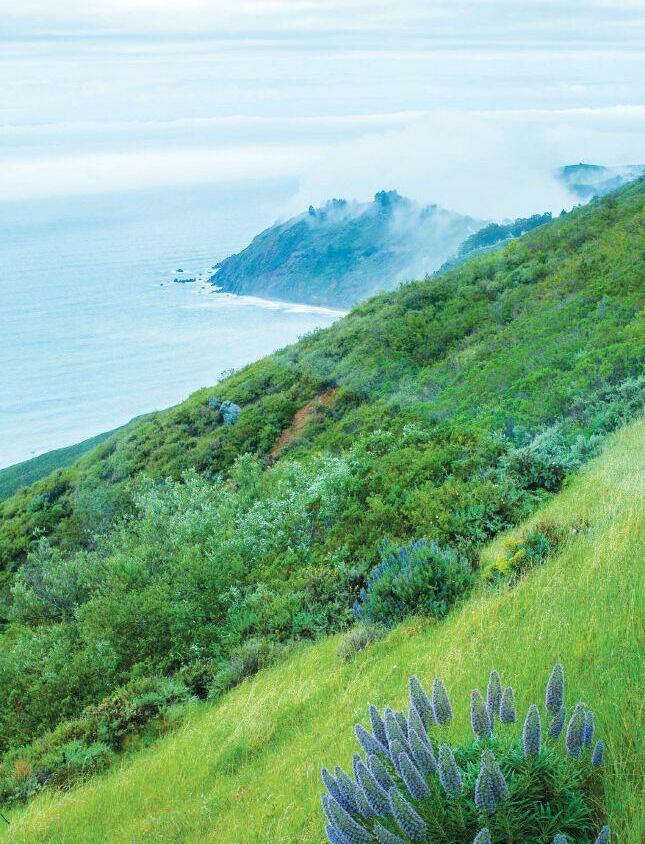

® AFTER THE STORM • FEAR IN THE FIELDS • MEANDER COOKING WITH SEAWATER • ALAN CHADWICK • ASIAN GREENS MARION NESTLE ON THE LOCAL FOOD MOVEMENT • INDIAN PICKLES Celebrating the Local Food and Drink of Santa Cruz, Monterey and San Benito Counties Summer 2017 • Number 24
of Edible Communities edible MONTEREY BAY
Member

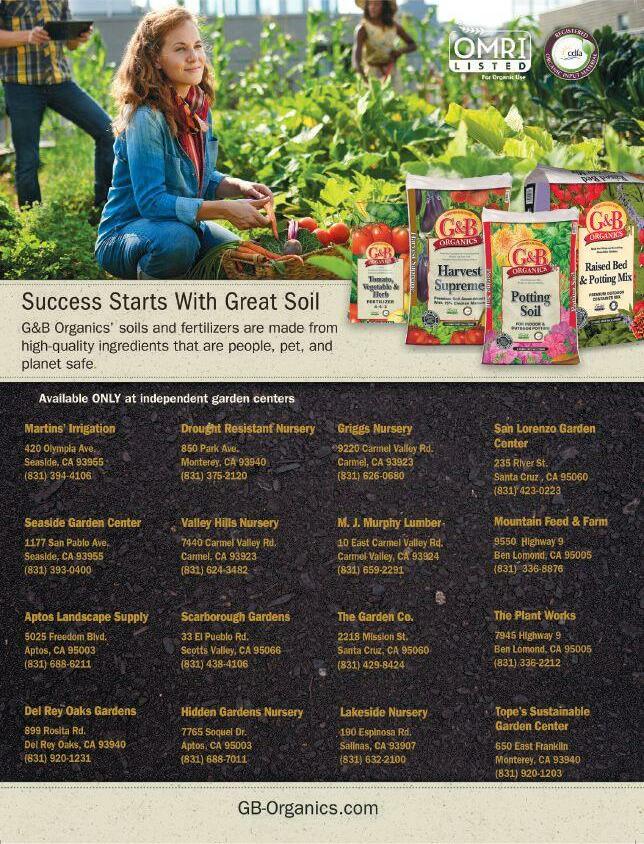
EDIBLE NOTABLES
Big Sur reopens for business, Meander throws a party on the San Lorenzo River, wagyu wranglers, Marion Nestle on where the food movement needs to go from here (hint: vote with your votes) 24 WHAT’S IN SEASON DEMYSTIFYING ASIAN GREENS
Punch up your meals with something new and nutritious 33 FOODSHED SUMMER FARMERS’ MARKETS
40 OUT TO SEA COOKING WITH OCEAN WATER
Beyond surfing and foraging, local chefs find new ways to play with the Pacific 48 ON THE FARM FEAR IN THE FIELDS
Increased immigration uncertainty deepens problems for local farms and farmworkers 56
EDIBLE ICONS ALAN CHADWICK
80 FIRST PERSON STRANDED
e Big Sur wilderness and a lot of love provide an improvised dinner party south of the failed Pfeiffer Canyon Bridge
COVER PHOTOGRAPH Big Sur in bloom by Michelle Magdalena
CONTENTS PHOTOGRAPH Farmworkers and their crops in a field at Tanimura & Antle in Spreckels by Michelle Magdalena
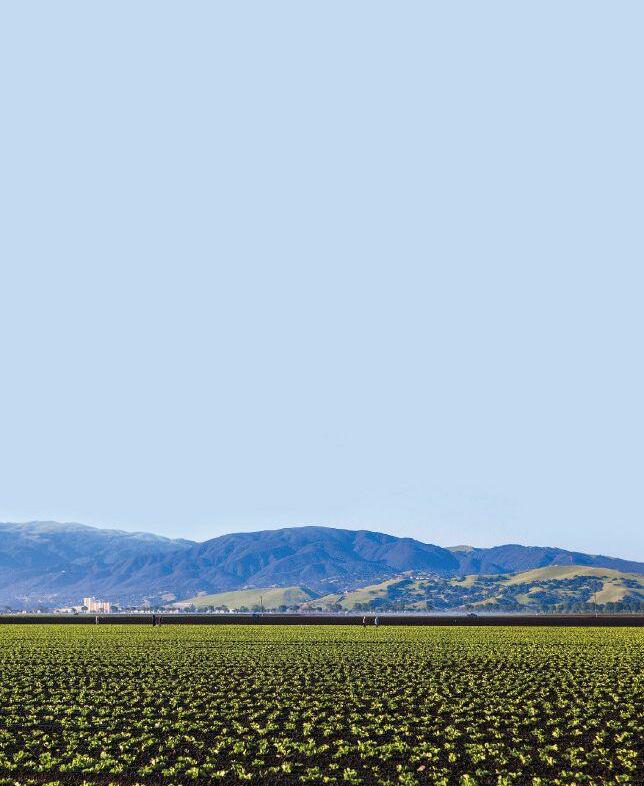
A complete guide for the Monterey Bay area 36 EDIBLE
ARTISANS
BACKYARD BAKER
Crusty wood-fired loaves made by Evan Lohr inspire a cult following
On the occasion of the 50th anniversary of UCSC’s Alan Chadwick garden, Paul A. Lee remembers the English gardener who helped ignite the local organic farming movement 60
THE PRESERVATIONIST INDIAN PICKLES
e secret to preparing authentic Indian cuisine 63 DINE LOCAL GUIDE 77 LOCAL SOURCE GUIDE
RECIPES IN THIS ISSUE: 29 Pea Tips Stir-fried with Garlic 30 Simple Stir-fried Pea Tips 42 Mezcal and Seawater Martini 42 Seawater Pickle Brine 43 Seawater Pickled Prawns 45 Seawater Kimchi 47 Seawater Caramels
More online at www.ediblemontereybay.com/recipes: Simple Seawater Brine
2 edible MONTEREY BAYSUMMER 2017 4
GRIST FOR THE MILL 9
Contents

edible MONTEREY
BAY
GRIST FOR THE MILL
At a time when the pressures of contemporary life seem bent on scattering our minds, shattering our communities and dragging us away from what is natural, sensible, intelligent, kind and fun, thank God for food. One of our most elemental and universal needs, food drags us back to reality. Food provides essential glue to our communities. Food slows us down and brings us to our senses. Food is an expression of our love.
In this issue, our talented writers and photographers tell the stories of our region and our times through the lens of food, as they always do. But we think the stories this quarter are especially timely, and we’re particularly proud of them.
In our main feature, Elizabeth Limbach investigates the dire plight of our farmers and farmworkers at a time when their struggles to keep their farms and families thriving are being exacerbated by an anti-immigration national agenda. e story explains why the very food on your table—and your ability to sleep at night—will depend on the citizens and leaders of our country informing themselves about this topic and making practical and humane immigration reform a reality.selves about this issue and making practical and humane immigration reform a reality.
Our cover image is a reference to two stories related to Big Sur, the first about the efforts of Nepenthe and other local restaurants and community organizations to get this willfully wild corner of the planet back into business after the past year’s extreme fire-and-flood cycle essentially cut it off from vehicular travel. e other is an essay about a lovingly foraged dinner held by a group of Big Sur friends to break the monotony of living on canned sardines. Both demonstrate the incredible community-building power of food.
Paul Lee’s memoir about Alan Chadwick and the founding of UCSC’s Alan Chadwick Garden, provides a fascinating view of the man, his ideas, and the garden that would eventually have a profound impact on the university community, the region, and—with the garden’s evolution into the Center for Agroecology and Sustainable Food Systems—agriculture around the world.
In this issue you’ll also learn about an artisanal bread maker who with his business has taught customers that it’s not so hard to make their own, and a Santa Cruz group that is reclaiming the San Lorenzo River from neglect by—what else?—throwing parties on its banks with delicious local food and drink.
To stretch the horizons of your cooking at home, we offer stories on getting to know Asian greens, cooking with seawater and making Indian pickles. And, with the help of some wonderful sponsors, we are bringing back the print version of our local farmers’ market guide in beautiful illustrated form. (e digital version also remains at www.ediblemontereybay.com.)
Finally, on the occasion of the 15th anniversary of Edible Communities, the network of magazines of which this one is a part, we offer a reflection on the national local food movement by one of its most important leaders, Marion Nestle. Her message? Keep your eyes on the prize, now more than ever.
Best wishes for a healthy and happy summer,
Sarah Wood and Rob Fisher Publishers

PUBLISHER AND EDITOR
Sarah Wood Sarah@ediblemontereybay.com 831.298.7117 or 831.238.1217
CO–PUBLISHER AND ASSOCIATE EDITOR Rob Fisher
DEPUTY AND DIGITAL EDITOR Deborah Luhrman
COPY EDITOR Doresa Banning
LAYOUT DESIGN Melissa Petersen
SOCIAL MEDIA MANAGER Katie Reeves
EDITORIAL ASSISTANT AND EVENTS MANAGER Rosie Parker
AD DESIGN Dina Clark • Bigfish Smallpond Design • Jane Bolling Design • Kjeld Petersen Marilet Pretorius • Melissa oeny Designs
CONTRIBUTORS Crystal Birns
Jordan Champagne • Jamie Collins • John Cox
Leslie David • Zoe Fisher • Kodiak Greenwood
Margaux Gibbons • Bill Hayes
Linda Sonrisa Jones • Paul A. Lee
Elizabeth Limbach • Michelle Magdalena
Camilla M. Mann • Kathryn McKenzie
Marion Nestle • Andrea Nguyen • Rosie Parker
Zephyr Pfotenhauer • Lily Stoicheff Patrick Tregenza • Amber Turpin
ADVERTISING SALES
ads@ediblemontereybay.com • 831.238.1217
Shelby Lambert shelby@ediblemontereybay.com Kate Robbins kate@ediblemontereybay.com Sarah Wood sarah@ediblemontereybay.com
DISTRIBUTIONMANAGER Mick Freeman
CONTACT US:


Edible Monterey Bay P.O. Box 228, Carmel Valley, CA 93924 www.ediblemontereybay.com 831.298.7117 or 831.238.1217 info@ediblemontereybay.com
Edible Monterey Bay is published quarterly. All rights reserved. No part of this publication may be used without written permission of the publisher. Subscriptions are $28 per year at www.ediblemontereybay.com. Every effort is made to avoid errors, misspellings and omissions. If, however, an error comes to your attention, please accept our apologies and notify us. We also welcome letters to the above address. ank you.
4 edible MONTEREY BAYSUMMER 2017
Photo by Zoe Fisher




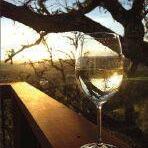
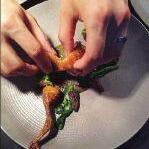
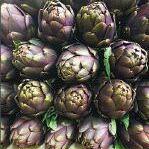


www.ediblemontereybay.com 7 Join the conversation and share your discoveries... ...and we’ll share ours with you. Stay connected with Edible Monterey Bay staff, contributors and readers. Subscribe to our e-newsletter online at ediblemontereybay.com and follow us on our social media channels. Edible Monterey Bay @ediblemontereybay @ediblemontbay @ediblemb @bry_photo @drinkthiswine @companionbakeshop @alabarto @yoli619
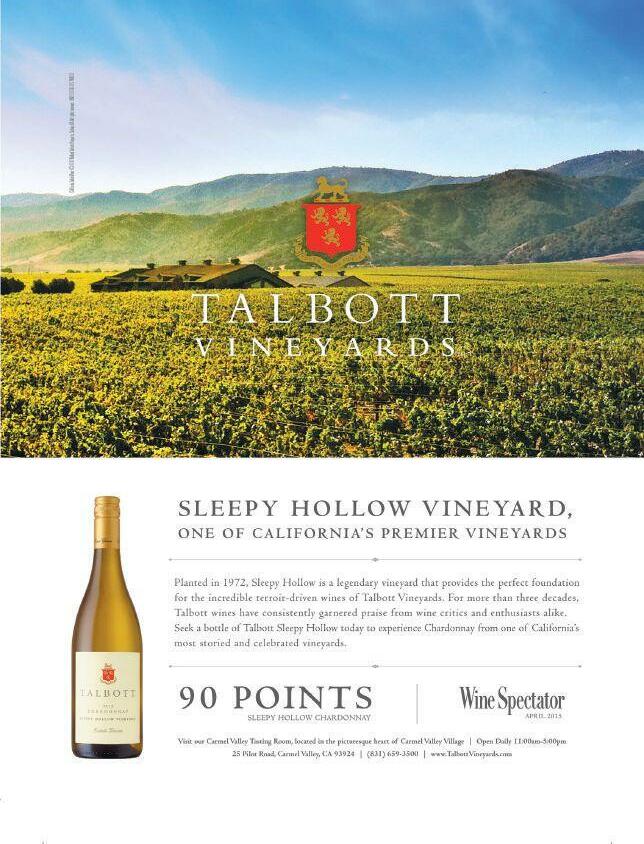
EDIBLE NOTABLES AFTER THE STORM
Why now is the time to visit Big Sur
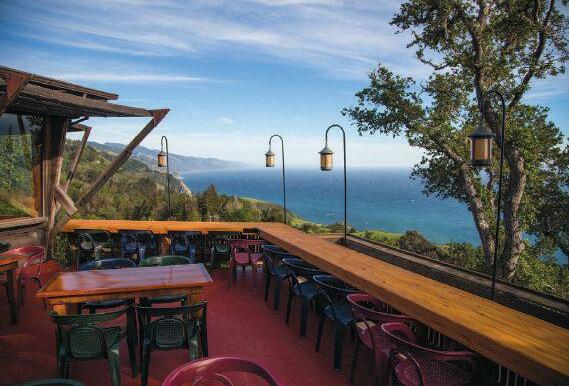 BY KATHRYN MCKENZIE PHOTOGRAPHY BY KODIAK GREENWOOD
BY KATHRYN MCKENZIE PHOTOGRAPHY BY KODIAK GREENWOOD
Kirk Gafill is experiencing both the stress of being a business owner and a family man in the 45-mile stretch of Highway 1 that last winter became known as “Big Sur Island.”
Cut off from car travel to the rest of the world last February after a series of extreme storms battered the coast, causing landslides to the south and a bridge failure to the north, the “island” is home to iconic restaurants like Gafill’s family-owned Nepenthe restaurant, a Big Sur landmark since 1949. After being forced to shut down for a brutal eight weeks, Nepenthe reopened just as this issue of Edible Monterey Bay was going to press, with the hope of serving 40 to 60 meals a day at first, down 90% from the usual 400 to 600, as continuing road closures meant that its guests would be mostly limited to locals and the handful of tourists being helicoptered in to next-door Post Ranch Inn.
e storms have also forced Gafill, Nepenthe’s general manager, to endure lengthy separations from his wife and son, who after the bridge went out began staying on the Monterey Peninsula so that his son could attend his usual classes at Carmel High School. e arrangement meant that seeing his family typically required Gafill to hike a half-hour through Pfeiffer Big Sur State Park on a steep and winding trail open just to locals, then drive up in a car parked on the other side—a process that added an hour or more to the trip, and could be delayed by weather and road conditions. (And the alternative, a backroads loop south to Nacimiento-Fergusson Road and north via Rt. 101 available to locals at strictly regulated times, takes hours longer.)
“is year has been the granddaddy of them all,” says Gafill. “Mother Nature really knocked us out—it’s definitely the most challenging that I can remember.”
Doing business in Big Sur has always been a challenge. But what Gafill—and the rest of the Big Sur hospitality community—have been facing in recent months offers a peek into the particular difficulties of running a restaurant in this stubbornly wild corner of the region—and a sense of why its denizens are so grateful for the outside help that got the area at least partly back in business in time for summer.
“Restaurants on the Peninsula immediately stepped up and made jobs available” for employees of affected Big Sur establishments, he says, and Monterey County churches and community groups also quickly offered aid and assistance. Also lending a helping hand was e
www.ediblemontereybay.com 9
“It’s not going to be a normal season by a long shot, but it will be a superior and unique experience for those who come.”
Barnyard in Carmel, which hosted the Big Sur Fashion Show in May and made room for a new venue for the Henry Miller Memorial Library, which aside from being a shrine to the late author, is a bookstore and vital performance center for the Big Sur community.
Even more promising, a regional task force came together to find ways to encourage travel to Big Sur this summer, along with taking a long-term look at tourism challenges in the area.
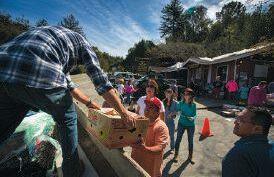
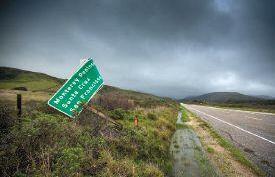
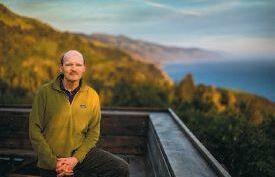
e fire-and-flood cycle is nothing new for the remote coastal community, but the past year has been extreme and extraordinary. It began with the devastating Soberanes Fire last summer, which destroyed dozens of homes and laid wildlands bare after burning more than 11 weeks and consuming more than 130,000 acres. In the winter, almost 80 inches of rain caused slides, slips and irreparable damage to the Pfeiffer Canyon Bridge, which was demolished in March to make way for a new span to be installed by mid-September. At press time, Caltrans was aiming to open car traffic to the public from the north and south via Nacimiento-Furgusson Rd. and Rt. 101 by mid to late June, but the active Mud Creek slide had cut off public travel on Rt. 1 north to Big Sur from further south until further notice.
But even after Highway 1 opens to the south, chances are that there won’t be anything like the usual onslaught of tourists who normally come through Big Sur during the summer. Some 3 to 4 million people visit in a typical year, the majority in spring, summer or fall. (Businesses on the north side of the Pfeiffer Canyon gap, like Big Sur River Inn and Fernwood, continue to be open and accessible to the public, although as of press time most state parks in Big Sur were still closed.)
“We’re not going to get the drive-through traffic,” this summer, says Stan Russell, general manager of the Big Sur Chamber of Commerce, noting that tourists usually combine their visits to Big Sur with a drive to or from the Monterey Peninsula or San Francisco Bay Area.
“We’ve gone from fires to floods to mudslides,” says Russell. “It’s a tough double-whammy to come back from.”
Nepenthe and its Phoenix Gift Shop, Post Ranch Inn and Hawthorne Gallery reopened on April 20 despite the obvious complexities involved with staffing and supplies. Deetjen’s Big Sur Inn, which offers lodging and meals, was planning to reopen when access to the south opened. “We will more than likely have a slightly modified menu and very slimmed down staffing numbers but we are really looking forward to reopening,” says spokeswoman Jeanne Crowley, who notes that storm damage to some rooms is being assessed and plans are being made to stabilize a hillside. Other establishments, like Ventana and Big Sur Bakery, declined to name an opening date (although the bakery has been having wildly successful pop-ups in Carmel). Big Sur Tap House and Big Sur Deli never closed.
Nepenthe’s closure after the February storms was its longest ever, but Gafill saw it as a perfect opportunity to shine it up, so he embarked on a massive cleaning and refurbishing project. “We’ve been cleaning, painting, resurfacing,” he says. “e bar looks the best that it has since (Nepenthe opened) in 1949.”
Scenes following a disaster: Kirk Gafill and the historic view from Nepenthe, a sign blown down by high winds, food aid from the Monterey Peninsula, and the now-demolished old Pfeiffer Canyon bridge after landslides caused it to slide itself and break apart.
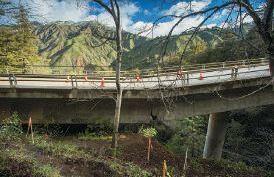
10 edible MONTEREY BAYSUMMER 2017
Opening in time to celebrate the restaurant’s 68th anniversary in April was important to Gafill; it’s also what Big Sur needed to kick off its recovery and put employees back to work, he says, not that it’s going to be easy with limited food and supply deliveries, as well as a whole host of ongoing challenges for residents.
Nepenthe is one of the legendary places that people think of when they dream of Big Sur, with a view from its deck that seems to go on forever across the Pacific.
When his grandparents Bill and Lolly Fassett bought the property in 1947, Highway 1 was a mere decade old, and Americans were just starting to catch on to what a spectacular drive it was. anks to the lifting of World War II gasoline rationing and the desire of newly prosperous families to hop in their Chevrolets and go sightseeing, Big Sur became a sought-after destination.
Now the push to make Big Sur accessible again has been taken on by a multi-agency effort, the Big Sur Economic Recovery Task Force. Formed by supervisor Mary Adams and including the Monterey County Hospitality Association and the Monterey County Convention and Visitors Bureau, the organization is looking at a variety of options for transporting visitors and employees to Big Sur. e agencies are also examining long-term issues concerning Big Sur tourism, such as availability of public restrooms, degradation of the environment and illegal parking, says Butch Kronlund of Coast Property Owners Association Big Sur.
All that being said, the current challenges facing Big Sur tourism aren’t entirely a bad thing.
For the first time in many years, there are now last-minute stays available in the accessible area north of Pfeiffer Canyon—and some are less expensive than usual. “Booking.com is now offering discounted rooms,” says Russell. (Glen Oaks Big Sur is among those offering deals.)

And without the usual din of traffic and crowds of tourists, this year will also offer a singular opportunity for visitors to relish the stillness and hear the sounds of birdsong and rushing water in the distance.
“It’s not going to be a normal season by a long shot, but it will be a superior and unique experience for those who come,” says Gafill. “It’s going to be one of the most exclusive enclaves in the world—you can come and enjoy Big Sur as people haven’t enjoyed it for several generations…this is like what it was like for me as a child.”

Kathryn McKenzie, who grew up in Santa Cruz and now lives on a Christmas tree farm in north Monterey County, writes about sustainable living, home design and horticulture for numerous publications and websites.
BEFORE YOU GO: As of press time, while businesses north of the failed Pfeiffer Canyon Bridge were accessible by car to the public, the foot trail providing access from the north to businesses south of the bridge required passes that were still only available to people who live or work south of the bridge. Public car traffic to the area south of Pfeiffer Canyon bridge had not yet resumed. For the most up-to-date information, contact Caltrans (888.427.7623), the Big Sur Ranger Station (831.667.2315) and watch the blogs bigsurkate.wordpress.com and blogbigsur.wordpress.com.
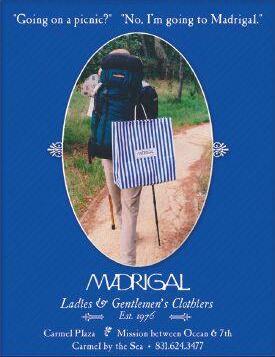
www.ediblemontereybay.com 11
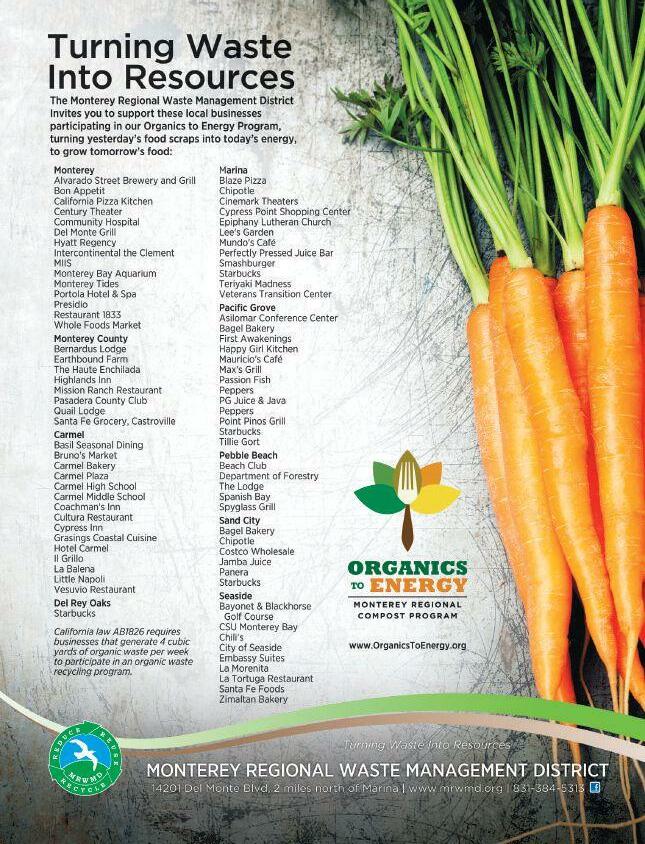
EDIBLE NOTABLES DOWN BY THE RIVER
Where some see a multitude of problems, Santa Cruz chefs ask, “What if…”
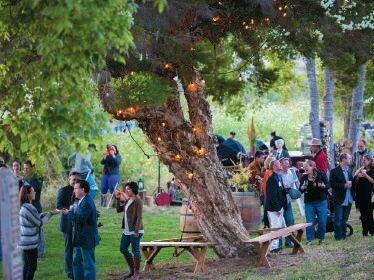

 BY DEBORAH LUHRMAN PHOTOGRAPHY BY CRYSTAL BIRNS
BY DEBORAH LUHRMAN PHOTOGRAPHY BY CRYSTAL BIRNS
Edging down the steep embankment, it felt like a secret world was opening up in the bushes alongside the San Lorenzo River in downtown Santa Cruz. Sun glinted off the silver Airstream of Breana White’s Kraft cocktail bar, a clutch of periscopes sprouted from the center of a field, old timey bluegrass music filled the air and waiters magically appeared bearing trays of bubbly and platters of nibbles.
El Salchichero chorizo and salami, lamb meatballs with sheep’s milk yogurt from Garden Variety Cheese and tempting crostini from Tabitha Stroup’s Friend in Cheeses Jam Co. were just part of the first round of the annual Meander dinner party—a locavore’s delight held every June to benefit the Coastal Watershed Council.
www.ediblemontereybay.com 13
While cities across the nation are revitalizing their riverfronts, the San Lorenzo River that flows straight through the center of Santa Cruz gets little love. Hidden between two flood levees, it usually dries up to a trickle in summer and its banks are a no-go zone for many residents, who worry about homeless people, drug use and crime there.
“We’ve kind of turned our backs on the river and left it to its own devices, and that’s unfortunate,” says Kendra Baker, chef and coowner of the fiercely local Penny Ice Creamery, Picnic Basket and Assembly restaurant.
Baker and designer Timerie Gordon are the masterminds behind Meander, responsible for convincing more than two dozen local food, wine and beer artisans to work together on the event to benefit the river.
“We are all passionate food people with varied interests, but what brings us to Santa Cruz, the reason we’re all here is because we value the natural environment and the beauty of what we have here,” says Baker.
Meander is designed not only to raise money for the CWC, but also to spark the imaginations of those who attend and provide a vision of what the Santa Cruz riverfront could be like.
“Lots of activities, dining and events are possible. I want to see more food and entertainment out there with our natural resources,” she says. “It’s the heart of Santa Cruz and we should embrace it.”
CWC is a nonprofit dedicated to protecting the watershed, and executive director Greg Pepping believes getting people down to the river is the first step.
“We want to reconnect the community to the river and help people realize there is this ribbon of green that runs through the city,” he says. “It’s where our water comes from, it’s home to some unusual species, it’s part of our history and it could be part of our future.”
Money raised at the dinner goes to fund year-round San Lorenzo River education programs for children and adults, but it is still a
challenge to attract the city’s attention. In addition to the social problems, there’s stiff competition from other natural attractions.
“is is a surf town and we have awesome waves, beaches and oceanfront, so people tend to ignore the river,” says Pepping. “en there’s the challenge of leadership. When was the last time you heard a politician make the river a top priority?”
Yet he feels privileged to be working on Meander with a virtual who’s who of the Santa Cruz artisanal food scene.
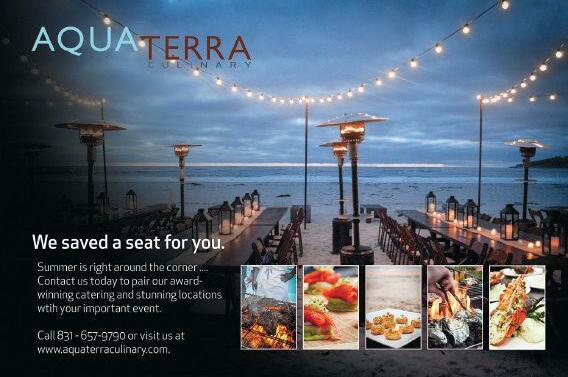
“Quality of life matters to them and to the readers of Edible, for example, and improving the river would improve the quality of life of the city,” he says.
e sit-down part of the dinner is a dazzling experience. Guests meander down the riverbank to a second clearing filled with the bustle of chefs cooking over an open fire. Jessica Yarr of Assembly works shoulder to shoulder with Mark Denham of Soif, for example, while other local culinary stars like
14 edible MONTEREY BAYSUMMER 2017
Damani omas of Oswald, Katherine Stern of La Posta, Heidi Schlecht of Feel Good Foods and Erin Lampel of Companion Bakeshop do their part. Chef Brad Briske of Home joins the group for this year’s event taking place on June 11.
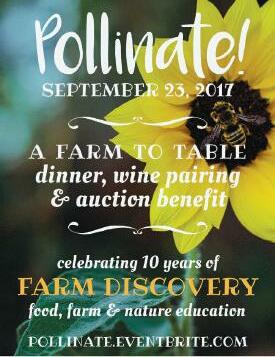
Dishes like warm shelling beans with squid, handmade spätzle with summer corn, local albacore and grilled pork loin are served family style at beautifully set round tables— which allow diners to face each other and maximize conversation.
“Really long tables are super dramatic and lovely looking, but make it difficult for people to connect,” says Gordon, the wildly creative designer in charge of the look and feel of the dinner.
She devised the periscopes so guests could look at photos of some of the CWC educational projects and she made sure each table was provided with an old-fashioned View-Master loaded with slides of river revitalization projects around the country and the
accompanying benefits, such as tax revenues and crime reduction.
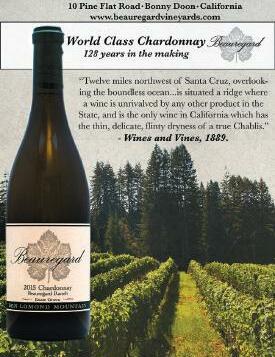
en near the dessert station, located under a string of party lights, Gordon created the “tree of commitment” decked with metallic streamers and ideas on how each guest could continue to interact with the river in the upcoming year. Take a hike, join a wildlife survey and have a picnic were some of the options—canoeing and kayaking are currently prohibited due to sensitive habitats.
“We’re trying to create memories,” says Gordon, who grew up along Soquel Creek in Capitola and loved taking part in the rowboat races. “When we can engage all the senses with the food, the drink, the social, the laughter, then it becomes ingrained.”
Kendra Baker—who also grew up on a river, in her case the American River near Sacramento— has a memory of her own of Meander: “ere were lights in the trees, the DJ was spinning music and it was that magic hour just after sunset. Everyone had rosy
cheeks and a glass of wine or a beautiful dessert in their hand. Everyone was happy and I could see that this is how we should be using this space.”
Deborah Luhrman is deputy editor of Edible Monterey Bay and editor of our weekly newsletter. A lifelong journalist, she has reported from around the globe, but now prefers covering our flourishing local food scene and growing her own vegetables in the Santa Cruz Mountains.
EXPLORE: To learn more about the Coastal Watershed Council or to obtain tickets for the next Meander, go to www.coastal-watershed.org/event/meander.

www.ediblemontereybay.com 15
WAGYU WRANGLERS
County chefs John Cox and Jeremy Tummel take their talent on the road, creating a destination well worth the trip at e Bear and Star in Los Olivos
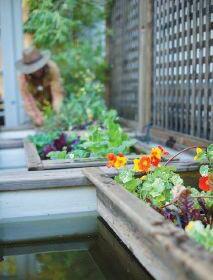
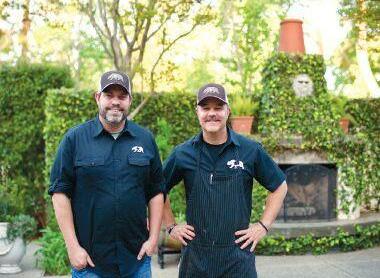 BY SARAH WOOD
BY SARAH WOOD
When John Cox first visited the stunning, 714-acre Fess Parker Ranch in Los Olivos last year, it was just as a favor to a friend, Paul Hoyle, president of the Fess Parker hotel group. Cox found himself on a tour past the ranch’s long-established vineyards and new wagyu cattle, as owner Eli Parker sought Cox’s advice for selling the prized beef to restaurants.
But Cox immediately saw potential for something even better. He imagined creating a restaurant for the Parker family where they could serve the wagyu and other products from their ranch themselves.
“It would be such a waste for that wagyu to go out of the family— no one is going to have the same connection to those animals,” Cox says. “You talk about the terroir—as soon as you let go of something from the ranch, people are not going to appreciate it in the same way.”
e Parkers, heirs of the late actor Fess Parker, who was also the savvy real estate investor who purchased and deeply loved the ranch, lost little time in taking Cox up on the idea.
In August, just a month after Cox had helped open the wildly popular Cultura–comida y bebida in Carmel where he is a partner and con-


sulting chef, Eli Parker and his sister Ashley Parker made Cox a partnerchef in what would become e Bear and Star restaurant, and Cox started work on the project in September. (e restaurant name is a reference to California and Texas, the two states Fess Parker considered home. Both are influences for the restaurant’s “refined ranch cuisine.”)
Since then, this story of imagination, decisiveness and follow through has carried Cox and the Parkers rapidly through the hiring of culinary and beverage teams, a farming team, the relocation of a Parker family cattlewoman back to the ranch from New Mexico and an extensive and inventive reimagining of what had been an upscale Greek restaurant at the Fess Parker Wine Country Inn.
Katie Parker, a former bucking bull breeder and trainer who has been raising wagyu cattle for three years in the Southwest and is thrilled to be able to fulfill her beloved grandfather’s dream of raising them on the Los Olivos Ranch, can’t say enough about the creative, calm and organized leadership that Cox has brought to the enterprise.
EDIBLE
NOTABLES
Monterey
16 edible MONTEREY BAYSUMMER 2017
Photos this page and opposite, Katie Parker, by Rob Fisher
“It’s so incredible when the world aligns you with the right people,” Parker says.





For his part, Cox is amazed at what the team has been able to accomplish.
“It’s a very supportive and open environment but the team is also just very proactive in making things happen,” Cox says, adding that as a result, “the restaurant is way more exciting than anything I’d imagined six months ago.”

As this issue of Edible Monterey Bay was going to press in early May, the restaurant was just opening but had for weeks been testing its dishes at small tastings for family and friends.
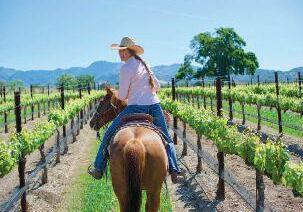








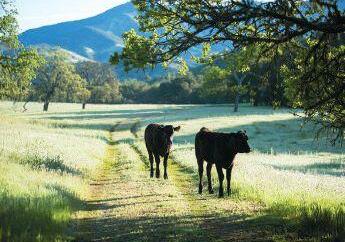

“For the most part, we’re thinking back to meals that really resonated with us growing up, re-envisioned for a modern California restaurant,” Cox says, describing the intent behind the restaurant’s cuisine and referring to his and sous chef Trent Shank’s childhoods in Texas, and chef Jeremy Tummel’s experience growing up on Santa Maria tri-tip in Santa Barbara.
Standouts at a tasting held one night a couple of weeks before the opening included deviled eggs prepared with Santa Barbara sea urchin and sea cucumber roe, and a remarkably umami-filled blackened tofu dish served with an update of Texas caviar, the tasty marinated salad traditionally built around black-eyed peas rather than fish eggs.
Other exceptional dishes included a melt-in-your-mouth, savory smoked wagyu carpaccio with cured egg yolk, koji, charred scallions, radishes and mushrooms; deeply flavorful wagyu tri-tip; and Morro Bay oysters dressed with a bright pink peppercorn and Meyer lemon mignonette.
Ranch to table: from left, John Cox and Jeremy Tummel on the Bear and Star’s patio, Miles McBreen tends aquaponic catfish tanks, Katie Parker takes visitors on a tour, and the wagyu on their range. Dishes from left are smoked wagyu carpaccio and e Bear and Star’s signature cornbread.
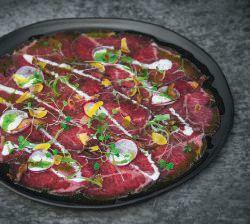
www.ediblemontereybay.com 17
Photos of food by John Cox, cows by Kodiak Greenwood
“It’s been overwhelmingly positive,” says Tummel, who was most recently chef de cuisine at Stillwater Bar & Grill in Pebble Beach, referring to the response to the small tastings the chefs had been staging, noting that “the key is going to be to keep that consistency when we’re doing 200.”
But amazingly, the food is likely to only get better, as ranch director Carly Connelly, who worked with Cox as assistant gardener at Post Ranch, and a multitude of other ranch staff, gradually ramp up the ranch’s production and replace the ingredients the chefs are purchasing with meat, vegetables, fruits and eggs produced right on the ranch. e plan is to feed the livestock grape pomace from the wine operation and spent grain from a Parker family member’s nearby craft brewery, Kris Parker’s ird Window, in something of a closed loop of sustainability akin to those of other farm-operating chefs who have inspired Cox, such as Dan Barber of Blue Hill at Stone Barns in upstate New York.
Katie Parker leads horseback rides at the beautiful hilltop ranch, where the family’s 300 acres of vineyards as well as 75 head of wagyu cattle and its chickens, quail, rabbits and organic row crops and heirloom fruit trees may be viewed; soon grazing pigs, sheep and beehives will be part of the scenery, too.
But guests don’t have to venture farther than the restaurant itself, located in downtown Los Olivos, to see the ingredients of a future meal being raised: Step onto the patio, and you’ll find an aquaponics system that the restaurant built with repurposed grape bins and uses to produce catfish, edible flowers and greens; venture into the “chef’s room,” a private dining room lined with Cox’s personal knife and cookbook collection, and you’ll find mushrooms growing in a glass tower, and through a window to the kitchen, microgreens thriving.
Aside from the chef’s room, diners can also be seated in the bar (where inventive cocktails like the mezcal-laced Ranch Hand Reviver are served), a secret wine room hidden behind a wall of wines, or the main dining room, all of which are bright and elegant yet relaxed.
e restaurant’s prices are also relaxed—especially considering the pedigree of the chefs and the quality of their ingredients.

Before you leave, just be sure to ask for a tour of the custom-made 30-foot-long mobile smoker out back. It’s just one of the fancy culinary toys Cox’s team is employing to work its magic, but it’s where the chefs honed their barbecue skills to walk away with awards from the San Angelo Stock Show and Rodeo Barbecue Championship in Texas in February—including a first prize for chicken and third prizes for brisket and overall performance.
e shiny belt buckle the chefs won as a trophy is proudly displayed on a wall outside of the kitchen.
“I couldn’t be happier,” says Cox of his latest restaurant adventure. “It’s really exciting.”
e Bear and Star 2860 Grand Ave., Los Olivos 805.686.1359 • www.thebearandstar.com
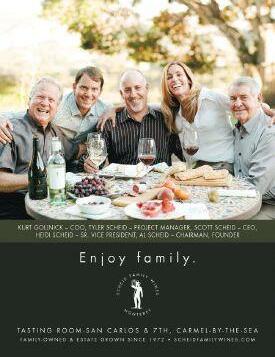
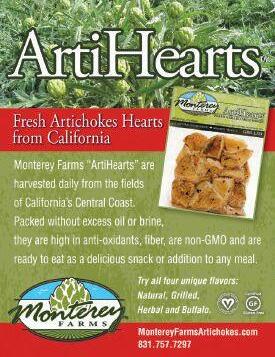
18 edible MONTEREY BAYSUMMER 2017

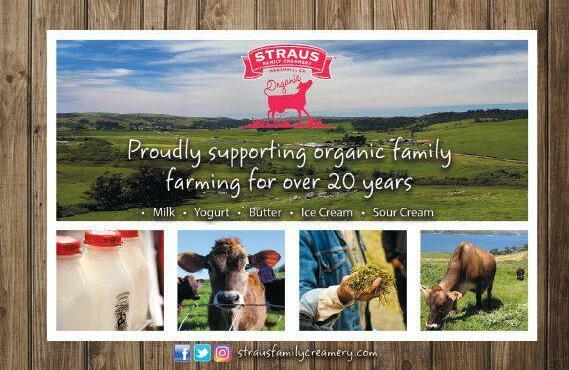
www.ediblemontereybay.com 19

EDIBLE NOTABLES WHERE TO FROM HERE?

e Local Food Movement 15 Years Later
BY MARION NESTLE
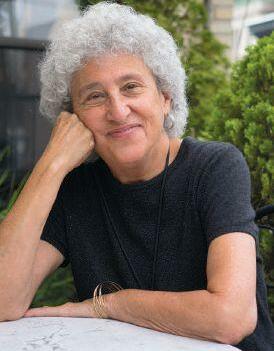
Edible Communities, the network of magazines of which Edible Monterey Bay is a part, began in 2002 with the launch of Edible Ojai, with which founders Tracey Ryder and Carole Topalian chronicled the rising interest in farm-to-table, local and organic foods. Since that time, Edible has grown to more than 90 independently owned and operated magazines across North America, winning along the way such accolades as recognition by the James Beard Foundation as “the voice of the local food movement.”
On the occasion of Edible’s 15th anniversary, food movement leader Marion Nestle looks back at how the local food movement has changed the way we eat and how the world can best ensure—via political action and other means—a healthy and sustainable food supply in the years to come.
Can it really be 15 years since Edible Ojai kick-started the Edible Communities contribution to the local food movement? Edible Communities has played such a vital role in the stunning changes that have taken place in the North American food world since the mid-1990s. At a time when global politics seem ever more intimidating and irrational, local food movements shine as beacons of empowerment and hope. By making food choices that support regional farmers and producers, we vote with our forks for healthier and more sustainable lives for ourselves, our children, our communities and our planet.
I use the word “vote” advisedly. Choosing local food is an outright act of politics.
I am a college professor and I hear all the time from students about how much they want to find work that will give meaning to their lives and help change the world, but how pessimistic they feel about whether this is possible in today’s political environment. ey see what needs to be done, but don’t know how or where to begin.
Begin with food, I tell them.
We need to do more than vote with forks to protect the gains of the last few years. We need to “vote with votes.” is means doing basic politics. e most important strategy by far is to write, call and meet with our own congressional representatives or their staff. If one person does this, they might not notice. But if several do, they pay attention. If many do, they pay more attention.
www.ediblemontereybay.com 21
Photo by Bill Hayes
ey are too young to realize how much the food movement already has accomplished: a lot. e food system has changed so much for the better since Edible Communities began its journey.
Here is my personal measure of its progress. In 1996, my New York University colleagues and I created undergraduate, master and doctoral programs in Food Studies. Everyone thought we were out of our minds: Why would anyone want to study food? But we got lucky. e New York Times wrote about our programs the week after they were approved. at very afternoon, we had students in our offices waving the clipping and telling us that they had waited all their lives for these programs. Now, just about every college I visit offers some version of a Food Studies program or food courses in fields as diverse as English, history, art and biology. Students see how food is an entry point to the most pressing problems in today’s society: health, climate change, immigration, the –isms (sex, gender, race, age), and inequities in education, income and power.
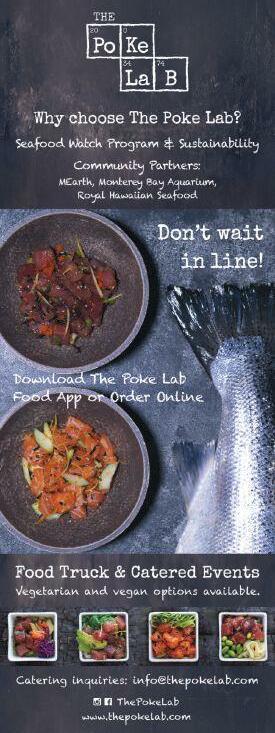
Some gains of local food movements are easier to measure than others. One of my favorites: e New Oxford American Dictionary added “locavore” as its word of the year in 2007.
e easiest to measure are those counted by the USDA, starting with farmers’ markets. In 1994, there were 1,755; by 2016, there were 8,669. e USDA is mainly devoted to promoting industrial agriculture but has had to pay attention (if a bit grudgingly) to the growth of local and regional food systems. It reports that about 8% of U.S. farms market foods on the local level, mostly directly to consumers through farmers’ markets and harvest subscription (CSA) arrangements. It estimates local food sales at more than $6 billion a year. is is a tiny fraction of U.S. food sales, but growing all the time.
More signs of progress: Since 2007, regional food hubs, which the USDA defines as collaborative enterprises for moving local foods into larger mainstream markets, have tripled in number. e USDA finds four times as many school districts with farm-to-school programs as it did a decade ago. It even notes the number of farms selling directly to retail stores or restaurants. As for what seems obvious to me—the increasing value of local food to local economies—the USDA remains hesitant (hence, grudging). It admits that “local economic benefits may accrue from greater local retention of the spent food dollar” but is withholding judgment pending further research.
e USDA partners with other federal agencies in a Local Foods, Local Places program aimed at revitalizing communities through the development of local food systems. ese not only involve farmers’ markets, but also cooperative groceries, central kitchens, business incubators, bike paths and sidewalks, and school and community gardens. is program may be minuscule in federal terms, but that it exists at all is testimony to how effectively local food movements have encouraged the development of home, school, community and urban gardens. e Edible Communities publications have both chronicled and championed all these changes.
One more measurable change: the increasing sales of organics. Organic production, of course, is not necessarily local but it is very much part of the food movement. Its growth is remarkable—from about $15 billion in sales in 2006 to nearly $40 billion in 2015. As the Organic Trade Association puts it, “Consumer demand for organic has grown
22 edible MONTEREY BAYSUMMER 2017
by double digits nearly every year since the 1990s.” is has happened so quickly that the demand now exceeds the supply.
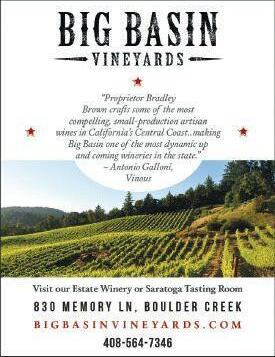
My last example: In the summer, even New York City supermarket chains proudly display locally grown foods, usually defined as coming from within New York, New Jersey or Connecticut, but still a lot closer than California or Latin America, where much of the city’s food usually comes from.
But the USDA has no idea how to measure the other critical accomplishments of the food movement. It is hard to put a number on the personal and societal values associated with knowing where food comes from and how it is produced.

Some months ago in e New York Times Magazine, Michael Pollan complained that the food movement is barely a political force in Washington, D.C., despite its having created “purchase by purchase, a $50 billion alternative food economy, comprising organic food, local food and artisanal food.” “Call it Little Food,” he said, pointing out that “while it is still tiny in comparison with Big Food, it is nevertheless the fastest-growing sector of the food economy.”
His concern was the need to consolidate these gains, join forces and exert power at the national level. Even in today’s political climate, this can—and must—be done. I’ve seen local food movements in the United States evolve over the years to increasingly converge with movements for organics, and also with those for better access to food and for health, food justice, environmental justice, food sovereignty, living wages and gender, and racial and economic equity. We need to keep doing this, now more than ever.
e congressional Freedom Caucus is doing all it can to revoke a long list of federal regulations, many of which deal with food. Its members want to do away with healthier school meals, the National Organic Program, food labels, menu labels and a host of food safety regulations. We need to do more than vote with forks to protect the gains of the last few years. We need to “vote with votes.” is means doing basic politics. e most important strategy by far is to write, call and meet with our own congressional representatives or their staff. If one person does this, they might not notice. But if several do, they pay attention. If many do, they pay more attention. Get friends to help.
We often hear it said that “all politics is local.” Local food movements prove that point. So much can be done at the local level to strengthen food systems and encourage community action. Real social change starts locally, and builds from there. at’s why Edible Communities matters so much. It is a force for strengthening local food movements, supporting community development and taking political action for a healthier and more sustainable future. May it flourish!
Marion Nestle is the Paulette Goddard professor of Nutrition, Food Studies and Public Health at New York University, and author of several books about the politics of food. For information, see www.foodpolitics.com and follow her @marionnestle.

www.ediblemontereybay.com 23
WHAT’S IN SEASON
Exotic greens for your summer cuisine: clockwise from lower left, baby bok choy, yam leaf, gui chai, pea tips and ching kang choy.
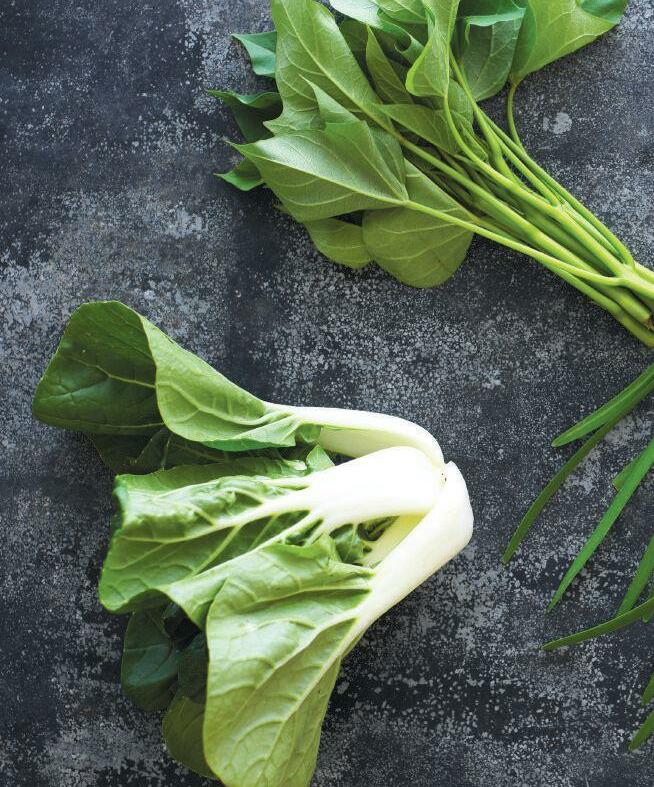
24 edible MONTEREY BAYSUMMER 2017
DEMYSTIFYING ASIAN GREENS
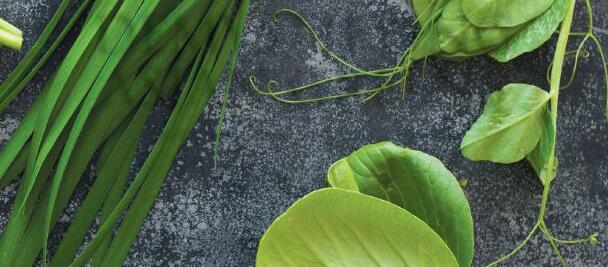
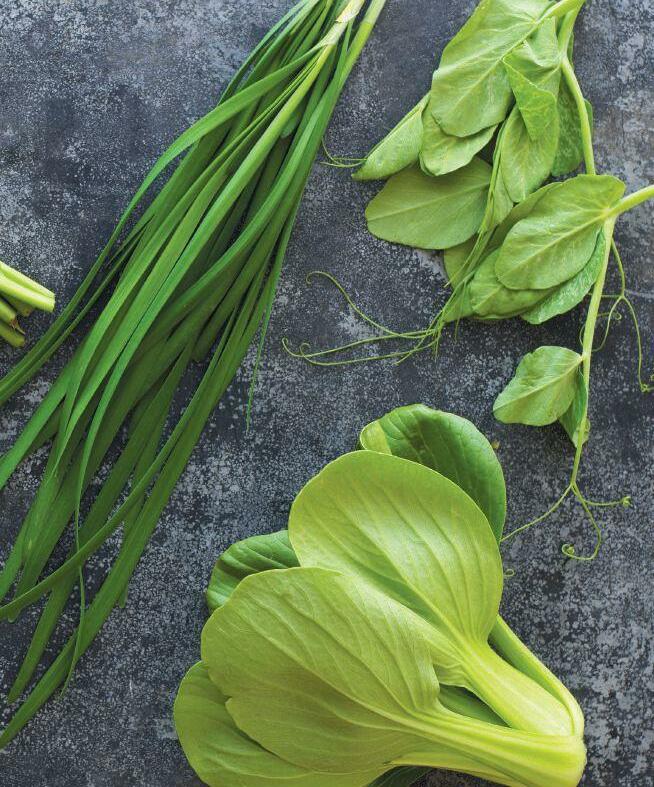
Punch up your meals with something new and nutritious
BY JAMIE COLLINS PHOTOGRAPHY BY PATRICK TREGENZA
www.ediblemontereybay.com 25
Have you ever been at the farmers’ market and found yourself intimidated or confused by the spread of locally grown Asian vegetables—so many leafy items displayed that you have never seen or tried before, right alongside unusual bumpy squash and purple and green beans that are so long they hang off market tables? Navigating the Asian vegetables can be a bit overwhelming. But it is worth your attention as most of them are grown for their nutrient value, tenderness and flavor, and a good portion are from heirloom seed. Knowing the basics will open a whole new culinary world of flavor, texture and health.
We at Serendipity Farms have been growing a few varieties of Asian vegetables—we’ve played around with pea tendrils, mustard greens, bok choy, tatsoi, mizuna and amaranth greens. It takes a lot of hand holding and free samples to convince shoppers to try something new, along with weeks of returning to the farm with unsold produce before a new green catches on, if ever. (is season I decided we would not be planting baby green mustard again!) But we find they are finally gaining traction with shoppers.
Some of the most nutritious plants common to Asian cooking are pea greens, otherwise known as pea shoots, pea tendrils, pea sprouts and pea tips. ey are prized for their nutritional and medicinal value—they are high in folate, vitamin C, fiber and protease inhibitors that prevent viruses and reduce LDL cholesterol in the blood.
We have been seeing pea greens really grow in popularity in recent years—probably because they are the ones I’m most passionate about! I like to make pea shoot pesto—a bright and tasty springtime spread in which the greens actually taste like peas and combine well with toasted pine nuts, Parmesan cheese and olive oil. Pea greens are also one of my favorite ingredients for egg dishes—I chop and sauté them in garlic before stuffing them inside an omelet, or scramble with goat cheese or avocado and slices of sundried tomatoes. Often I’ll add pea greens to smoothies because they are flavorful without being overpowering.
New Natives, a certified organic microgreens farm in Corralitos, has been growing baby pea sprouts for many years and selling them at Santa Cruz Farmers’ Markets and grocery stores throughout the Mon-
terey Bay area. As the pea sprouts are young and tender, they are great for eating raw in salads, tacos and sandwiches.

Linda Chu and Chris He of Benito Valley Farm in Hollister grow mature pea greens and a number of other Asian vegetables. Most of the demand for their products comes from conventional produce buyers in Los Angeles and San Francisco, but the farmers hope to begin distributing their crops locally soon. They are especially seeking wholesale and retail outlets for their CCOF-certified produce. “We are working on packaging the vegetables with other ingredients like oyster sauce and garlic with instructions on how to prepare them, hoping that it helps sell the organic in more of a mainstream market,” Chu says.”
As I walked the farm with them recently I noticed enormous chives growing in their greenhouse—much bigger and wider than the chives I am familiar with. Chu explained that the chives she grows, a variety of garlic chives called gui chai, are eaten like greens because they are flatter and softer. I took the chives home to prepare them with eggs (trying to invoke my version of egg foo young), and noticed they are much more garlicky and juicy than the ones traditionally used to add flavor to a baked potato.
Here are other Asian veggies you may find at your local market. (See p. 24–25 for what some of them look like.)
Ching kang is an heirloom green bok choy, which is a type of Chinese cabbage that is greener and softer than the big hybrids that boast huge, crunchy stems. Chu says the ching kang variety is not a big producer (as is the case with most heirloom varieties) but has more flavor and is one of their biggest sellers. I’ve grown both the red and green hybrid varieties of bok choy and discovered that I really appreciate how the thick stems hold up in rice noodle dishes, offering a texture and crunch that balances out the softness of the noodles. Bok choy is also very healthy for you—like other cruciferous vegetables, it contains nutrients that are said to reduce cancer risks.
Gai lan, known as Chinese kale or sometimes Chinese broccoli, has softer bluish-green, fat and glossy leaves. Unlike kale plants, whose leaves may be harvested several times, the whole gai lan plant is har-
26 edible MONTEREY BAYSUMMER 2017
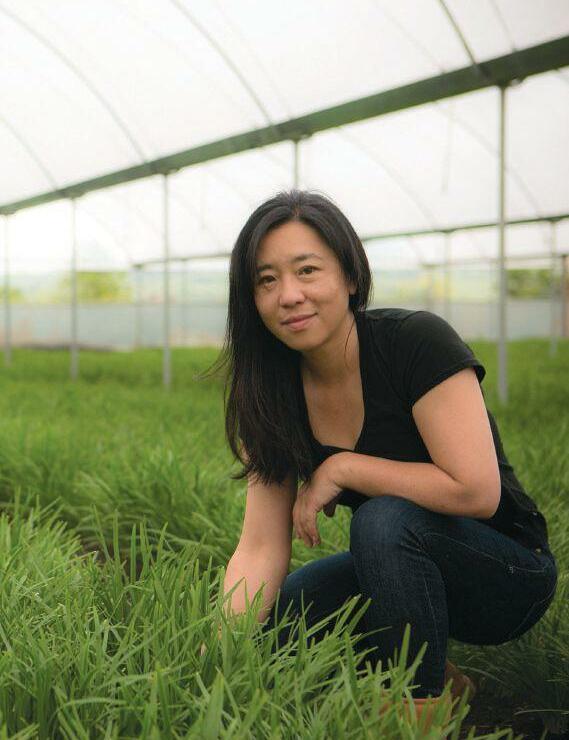
www.ediblemontereybay.com 27
“We are working on packaging the vegetables with other ingredients like oyster sauce and garlic with instructions on how to prepare them, hoping that it helps sell the organic in more of a mainstream market.”
—Linda Chu, Benito Valley Farm
vested once right before the flower blooms. Chu shared that the leaves are more tender than kale and with a milder flavor, not such an herbaceous taste. Common ways to prepare gai lan are stir fried with ginger and garlic or steamed and served with oyster sauce.
Young yam leaves are mild and tender enough to eat raw in a salad and can be used in any dish where spinach or other greens are called for. Consider tossing them in curries, stews and soups. ey also pair well with ginger and soy sauce; steaming them lightly maximizes the nutrient content.
A traditional Korean side dish called namul uses young yam leaves, and is served like a condiment. e leaves are typically blanched, but can also be boiled, sautéed, fermented, dried or steamed before being seasoned with salt, vinegar, sesame oil, soy sauce, miso paste or perilla oil, a vegetable oil used in Korean cuisine that originates from the seeds of the deulkkae plant.
Yam leaves are super fragile and will not last long after they are harvested, so be sure to use them the same day you buy them, if possible.


An interesting fact about the wild yam plant is that in the 1940s it was found to have a compound that can be converted into natural progesterone. It was one of the first oral contraceptives and is still used in some birth control and creams for naturally balancing hormones. But, not to worry, eating the leaves is not enough to cause hormonal changes. Instead, they are prized for being loaded with vitamins A, C, riboflavin and iron and for containing high levels of polyphenols, which are being studied for their ability to fight prostate cancer.
Wild yam leaves have also been used by native Americans and in Chinese medicine for nausea, rheumatoid arthritis, asthma and diabetes. Long ago, the Mayans and Aztecs figured out that the leaves are pain relieving, as well as an excellent food source. In the Philippines, young yam leaves are blended with baby food to increase the nutritional content. If you can get your hands on these wonderful leaves, load up and consider yourself lucky!
Gai choy is a type of Chinese mustard that is harvested when small for salad greens. When mature, it is cooked and commonly eaten with rich meats like lamb and pork or included in soups because of the depth
of peppery and pungent flavor. ere are 50 different types of gai choy with many varying flavors and characteristics including bau sin, nan fong, shi-li-hon and chi-sin. e fleshy green leaves can be crinkled or smooth, yet resemble a cabbage that refuses to form a head. Gai choy has been described as tasting like wasabi and gets stronger when cooked. It is often pickled with star anise, ginger, peppercorns and red chiles. Garlic, cumin, cilantro, fennel and cheesy or creamy sauces pair well with Chinese mustard. If the mustard plant flowers and sets seed, the condiment mustard can be made by smashing the seeds with a mortar and pestle or grinding in a clean coffee grinder, and adding salt and a liquid like beer, fruit juice, vinegar or even just plain water to make a mustard paste.
Mustards are great in crop rotation due to their bio-fumigant properties, which clean the soil of fungal diseases that affect crops like strawberries and tomatoes. So it is no wonder they also have healthful benefits for the human body. Gai choy contains high doses of sinigrin, which is believed to reduce the risk of certain types of cancers. It is popular in Chinese medicine as a reducer of inflammation, a cure for colds and can even be found as a liquid herbal remedy. Besides being grown for food and utilized for natural soil fumigation, gai choy is also being grown by Farm Fuel in Watsonville as a source for biofuel, making it a pretty fabulous plant!
Chinese spinach, also called yu choy mieu, is similar to gai choy because it is also a brassica in the mustard family, but it is harvested for the stalk and green leaves. When tender and young, use similar preparations as with other mustards, however, when mature the yu choy mieu stalks are tangy, bitter and fibrous and need to be cooked to be digestible. Mushrooms and shellfish pair well with Chinese spinach, and adding oyster or fish sauce and black vinegar provides the umami that ties the flavors together.
Amaranth greens are most often green in color, flaunting gorgeous streaks of red and purple. ey are grown in many parts of the world, for both the grain and the mild tasting greens. Originating in Mexico, amaranth greens are also common across Asia, Africa and the Caribbean where they are called callaloo, even though the name actu-
28 edible MONTEREY BAYSUMMER 2017
PEA TIPS STIR-FRIED WITH GARLIC (QING CHAO DOU MIAO)

I like this one with pea tips [rather than substituting other greens] because it’s saucier. If you multiply this stir-fry for more people, do it in batches. Otherwise, you’ll not reap the wok-hay benefits and the tips lose a bit of their zest.
6–7 ounces pea tips
6 tablespoons chicken stock 1 teaspoon cornstarch
1½ tablespoons rendered chicken or duck fat, or canola or peanut oil 2 or 3 large garlic cloves, minced Salt
Use your fingers to break off and discard the fine curly tendrils from each pea tip. en break the pea tips into 3-inch lengths, dropping them into a bowl. Set aside near the stove. (is is a great group task or assignment for kids!)
Combine the chicken stock and cornstarch and set aside near the stove.
Heat the fat in wok or large skillet over medium-high heat. Add the garlic and stir-fry for about 15 seconds, until aromatic.
Add the pea tips and a generous sprinkling of salt. Stir to combine and prevent the garlic from browning. When the pea tips have wilted to about one-third of their original volume, about 45 seconds, give the stock a stir, then add to the pea tips.
Stir and cook for about 30 seconds, until the liquid has thickened slightly. e pea tips should be now about one-quarter of their original volume, signaling that they are done.
Remove from the heat, taste for salt. Transfer to a plate or shallow bowl and serve.
www.ediblemontereybay.com 29
Courtesy Andrea Nguyen, Santa Cruz resident, author of e Pho Cookbook and publisher of Viet World Kitchen Serves 2
SIMPLE STIR-FRIED PEA TIPS

Courtesy Andrea Nguyen, Santa Cruz resident, author of e Pho Cookbook and publisher of Viet World Kitchen
Serves 4
is is written for pea tips, but it’s great with amaranth leaves or yam leaves. Just swap out the greens.
Swirl of canola oil
1 or 2 garlic cloves, finely chopped (optional)
11⁄3 pounds pea tips, tendrils removed and stiff pieces discarded (net 1 pound)
Kosher salt

Sesame oil
Heat a wok or large skillet over medium-high heat. Swirl in the oil, add the garlic and cook, stirring, until fragrant, about 45 seconds. Add the pea tips and a sprinkling of kosher salt. Stir-fry for several minutes, until wilted. If things seem dry, splash in water to facilitate cooking.
e pea tips are done when they’re about a third of their original volume. Dish out to a serving plate. Drizzle on some sesame oil.
ally refers to the traditional breakfast dish in Jamaica, where amaranth greens are cooked with chile peppers, onions and spices like cumin. Amaranth tastes similar to spinach and can be used in place of any tender green, while young leaves are best eaten raw and can be added to a salad or used as a microgreen. Compared with kale, amaranth greens have more vitamin K, calcium, folate, iron, zinc, magnesium and potassium—making them a star substitute in green juices and smoothies.
e next time you find yourself at the farmers’ market, think about expanding your horizons and choose an Asian green you have never used before. Be inspired, not intimidated, and ask the market vendors how to prepare their harvest, as the farmers know best how to eat the food they grow. Challenge yourself to try a few. All you need is a few ingredients like sesame oil and garlic to make these vegetables taste delicious. A whole new world awaits!
Jamie Collins is owner of Serendipity Farms, which grows organic row crops in Santa Cruz and Monterey counties and distributes them through a CSA, U-picks and farmers’ markets and a virtual farm stand which can be found on Serendipity’s Facebook page.
RECIPES: See left and p. 29 for Santa Cruz cookbook author Andrea Nguyen’s recipes for Simple Stir-Fried Pea Tips and Pea Tips Stir-Fried With Garlic (Qing Chao Dou Miao).
Benito Valley Farm Hollister • 831.902.6589 • lindachu3333@gmail.com
30 edible MONTEREY BAYSUMMER 2017
LOCAL FOODS IN SEASON
June, July and August
Fruits: *Apples • **** Apricots • Avocados Blackberries • ****Blueberries • *Boysenberries
Cactus Pears • **Cherries • Figs • ***Grapes Lemons **Loquats • ***Melons • Nectarines
Olallieberries • Oranges • Peaches • ***Pears • Plums Raspberries • Strawberries • Tayberries
Vegetables: **Artichokes • Arugula • **Asparagus
Basil • Beets • Bok Choy • Broccoli Cabbage Cardoons • Carrots • Cauliflower • Celeriac • Celery Chard • Chicory • Collards • Corn • Cress Cucumber • Dandelion • Eggplant • Endive • Fava Beans • Fennel • Garlic • Green Beans • Kale • Leeks Lettuces • Mushrooms • Mustard Greens • Onions Pea greens • Peas • ***Peppers, Bell • Potatoes Radishes • Spinach • Summer Squash • Tomatoes
Turnips
Seafood: Abalone • Crab, Dungeness • Halibut, California • Lingcod • Rock Cod (aka Snapper, Rockfish) • Sablefish (aka Black Cod) • Salmon, Chinook/King • Seabass, White • Squid, Market
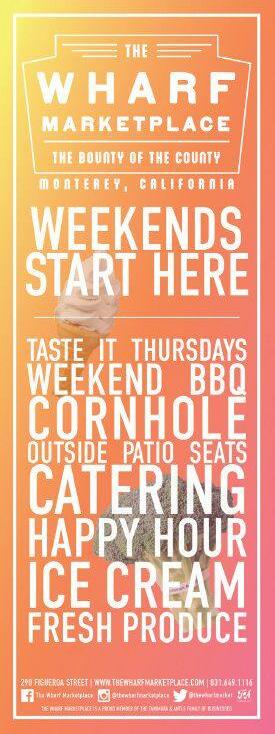
Sole (Dover, Petrale) • Spot Prawns • Tuna (Albacore)
*comes into season in June **ends in June ***comes into season in July ****comes into season in August *****goes out of season in July
Notes: No notation on fruits and vegetables means the crop is available the duration of June, July and August. All fish listed are rated “Best Choice” or “Good Alternative” by the Monterey Bay Aquarium’s Seafood Watch program and are found in abundance in local waters. See www.seafoodwatch.org for more information.
Research assistance provided by Real Good Fish and Serendipity Farms
www.ediblemontereybay.com 31


32 edible MONTEREY BAYSUMMER 2017




www.ediblemontereybay.com 35
EDIBLE ARTISANS BACKYARD BAKER
Crusty wood-fired loaves made by Evan Lohr inspire a cult following
BY LILY STOICHEFF PHOTOGRAPHY BY MICHELLE MAGDALENA
e first time I walked down the small lane off 26th Avenue in Santa Cruz where Evan Lohr lives and bakes, I wasn’t sure I was in the right place—until I rounded a bamboo-lined fence and saw a friendly face dusted with flour.
Tall and tan, with a surfer’s physique and oceanic blue-green eyes, Lohr wasn’t exactly the baker I thought I’d encounter. He greeted me with a rough hand and told me to pick any loaf I wanted from the baker’s rack. Heat radiated from the clay oven nearby as I chose a wide, crusty loaf scored with a fern. I couldn’t resist giving it a sniff, and a warm, heady bouquet spiked with the soft tang of fermentation filled my nostrils and made its way down my throat. My mouth watered. Without really thinking about it, I tore a chunk off with my hands. I’ve been back almost every week since.
Lohr has been baking bread for his family since he was a kid, and was selling at his local farmers’ market in Shasta County before he was old enough to drive. A few years ago, he found himself baking almost every day for his household and the occasional friend or neighbor, and he needed a larger oven. A natural

36 edible MONTEREY BAYSUMMER 2017
Just as purchasing produce from the local farmers’ market builds communal bonds, knowing my baker gives me the same slow food satisfaction.
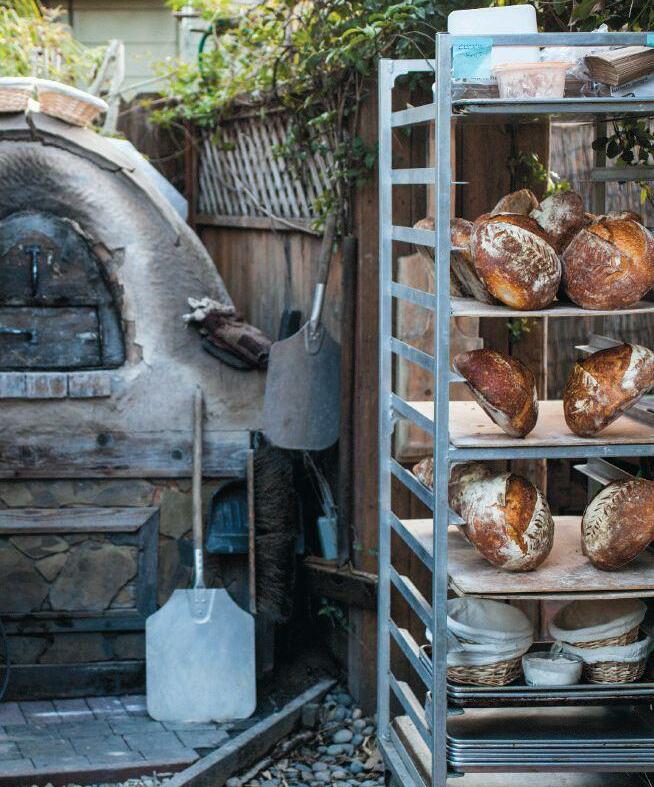
www.ediblemontereybay.com 37



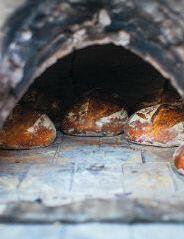
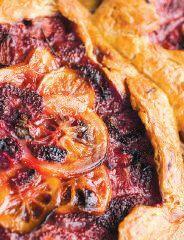

38 edible MONTEREY BAYSUMMER 2017
craftsman, Lohr built the earthen, wood-fired structure partly because he thought it would be a fun project and partly because he wanted to put it to good use. “One reason kind of chased another,” he says. “I wanted to see what the process was. And if you do something like that, shouldn’t you do something with it?” He began sending a text out to his friends and neighbors every week letting them know when he would be firing the oven, and then baked to order a few days later.
A couple months in, word started to get around. Lohr was baking small batches of eight to 11 loaves twice a week when his list of emails and phone numbers started to grow, with a few new people being added every week. Soon, it expanded beyond his immediate community to include friends of friends, then people he had just met. His unofficial bakery, 26th Ave Bread, was born.
is is about the point in the story when I first met Lohr, whom I still refer to as “my bread guy.” Visiting his East Side home might be more out of the way than stopping by the closest grocery store, but I look forward to these visits far more. Just as purchasing produce from the local farmers’ market builds communal bonds, knowing my baker gives me the same slow food satisfaction.
e popularity of his renegade bakery, which charges $5–$6 per loaf, has yet to influence Lohr’s low-key demeanor—more likely, his welcoming, friendly vibe has contributed to its success. e number of people on Lohr’s list has swelled to more than 400,

but he takes it in stride. “It’s not that I’m not surprised because I think that I’m doing something that’s so great, but I mean, I would buy bread from me,” he says nonchalantly.
Limited by its size, available counter space and how much flour and ash he’s willing to subject his girlfriend to, Lohr has exceeded the capacity of what he can produce out of his home. So by the end of this summer, 26th Ave Bread will move a few doors down to the new Two Six Market at 400 26th Ave. (previously Kong’s Market). Lohr and his business partner Dave Anderson plan on updating the market to provide a small grocery and sell bread, baked goods and wood-fired pizzas out of a larger oven Lohr plans to build. It’s a sustainable shift for Lohr, who is pushing the boundaries of what is acceptable within California’s cottage food law. Moving to a commercial space would give him peace of mind.
For Lohr, the expansion of his circle has been the most rewarding result of this project. “I’ve developed this amazing community of people, I guess you could call them like minded, but just doing fun things,” he says. “I thought I had a pretty neat social sphere, but now it’s expanded to include all these people who aren’t the same age or have the same interests, who aren’t people who would normally fall into your circle.”
Lohr has also become a mentor to other bread enthusiasts, whom he affably refers to as “the bread interns.”
“I’ve got about a dozen people in the early stages of bread baking,” he says. “Some of them are extremely hands on with me and want to touch and do and feel. Others have an understanding, but are having problems. It’s a whole eclectic mix of people who want to learn more about bread and are excited to come over and find out more about their own process.”
Although he won’t take credit for inspiring these amateur bakers, he admits that seeing his operation helps them see how easy home bread baking can be. “ere’s so many small bakeries popping up with their lines out the door because people want a product like this. When people come over and see what I’m doing, it makes it seem much more accessible,” says Lohr. “It doesn’t really take more than the ingredients that are easily available, your hands and time.”
Lily Stoicheff is an eater and writer living in Santa Cruz with a soft spot for points of historical interest and a pickling passion that threatens to take over her fridge.
26th Ave Bread
Santa Cruz 831.406.7089
www.instagram.com/26th_ave_bread/
Two Six Market
400 26th Ave., Santa Cruz

www.ediblemontereybay.com 39
In addition to mineral nuances, seawater has a savory-umami quality.

40 edible MONTEREY BAY SUMMER 2017
OUT TO SEA
COOKING WITH OCEAN WATER
Beyond surfing and foraging, local chefs find new ways to play with the Pacific
STORY AND PHOTOGRAPHY BY JOHN COX AND MICHELLE MAGDALENA

Why don’t we cook with seawater? Chefs and food lovers adore the briny taste of a fresh-shucked oyster and don’t think twice about sprinkling food generously with flaky sea salt, but many seem shocked by the idea of cooking with ocean water.
While cooking with seawater may not be common here in California, it is more accepted in kitchens around the world. In fact, companies in both Greece and Scotland have recently introduced filtered and sanitized seawater for cooking. In Maine, corn and lobsters are frequently boiled in seawater. e Japanese reduce seawater down to collect nigari, the coagulant used in making tofu. Olives originated in the Greek Islands where they were leached of their tannins through submersion in the sea—a practice still common in some parts of Greece. Many bakers swear by seawater as a primary ingredient in bread; cheesemakers in New Zealand are using seawater to curdle their milk. Koreans used to store wilted vegetables in seawater, a precursor to kimchi.
In the Canary Islands, cooks simmer small potatoes in seawater and then dry them in the oven until the outsides shrivel and the sea salt blooms into a white crust. is local delicacy, called papas arrugadas or “wrinkled potatoes,” is served with a mojo sauce or salsa verde. e traditional dish has spread around the world, including to the Orkney and Shetland Islands.
e Ancient Romans prepared a dish called “Quarter of Wild Boar à la ébaine,” which called for cooking the meat in seawater flavored with bay leaves. When very tender, it was served with salt, mustard and vinegar.
Of course we can’t forget the iconic American East Coast treat, salt water taffy! Actually, despite its name, salt water taffy does not contain seawater. In fact, it usually doesn’t even contain salt. Urban legend speculates that a candy shop in New Jersey was flooded, and the owner made the most out of the situation with some clever marketing.
Potential reasons why using seawater in cooking has not taken off here in America include health concerns, the foremost being excessive sodium consumption. Doctors have argued that adding seawater to dishes is reckless and promotes an unhealthy diet. However, seawater actually averages around 3.5% salinity, making it less concentrated in salt than many brines and pickles, which often range from 5–7%.
Although seawater may not seem like much more than salty water, it has a depth and complexity that is hard to describe, and which can only be attributed to the various minerals and trace elements found in a particular location. To understand this concept you can put each of two peeled potatoes in a separate pot. In one pot put 1,000 grams of seawater, and in the other put 965 grams of water and 35 grams of kosher salt. You will likely find that the potato cooked in the seawater tastes like it is better seasoned even though the amount of sodium is the same. Of course, just like sea salt, ocean water can vary in its intensity and flavor. In addition to mineral nuances, seawater has a savory-umami quality.
It is always best to source seawater far from shore and avoid collecting water after a heavy rainfall. e water you collect should
be brought to a boil and then passed through a coffee filter before use.

Since seawater is not as salty as you might expect, when used as a brine for meats or pickles it is often necessary to add additional salt to reach the desired salinity. While seawater’s average of 3.5% salinity is a good base level for brines and pickles, that doesn’t account for any additional ingredients like sugar or vinegar that will ultimately reduce a recipe’s salinity.
I was curious to see what some of Monterey’s most creative chefs would do with seawater, so I went to the Monterey Abalone Co. and got a few gallons of filtered water to share with my friends. Here are the recipes they came up with along with some thoughts along the way.
e former executive chef at Post Ranch Inn’s Sierra Mar, John Cox is now pursuing a number of projects, including serving as a partner and consulting chef at Cultura–comida y bebida in Carmel and chef-partner at e Bear and Star at the Fess Parker Wine Country Inn in Los Olivos. For more, go to www.cheohncox.com or follow him on Instagram and Facebook.
RECIPES: See p. 42–47 for Kyle Odell’s Mezcal and Seawater Martini, James Anderson’s Seawater Kimchi, Michelle Estigoy’s Seawater Pickled Prawns and Yulanda Santos’ Seawater Caramels. See www.ediblemontereybay.com for John Cox’s Simple Seawater Brine.
www.ediblemontereybay.com 41
Photo by Michelle Magdalena
MEZCAL AND SEAWATER MARTINI
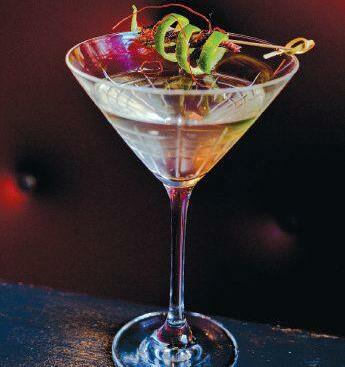 Courtesy Kyle Odell, bartender, Cultura–comida y bebida in Carmel
Courtesy Kyle Odell, bartender, Cultura–comida y bebida in Carmel

Serves 1
My first inkling was to make a seawater cocktail based off a classic martini. Traditionally a “dirty” martini includes olive brine to add a satisfying salty, bitter and savory component. However, when I tested a classic vodka and gin martini with seawater, the result was surprisingly unappealing. In fact, it was pretty disgusting! I decided to try mezcal as the base spirit and make my own pickle brine out of the seawater to complement the seawater’s characteristics. e tart, salty and slightly sweet brine combined with savory aspects of the mezcal to reveal a pleasantly balanced cocktail.
2 ounces Wahaka Espadin Mezcal
1 ounce seawater pickle brine
1 spritz dry vermouth
Pour all ingredients into a mixing glass with ice cube, stir well. Strain into a chilled martini glass. Garnish with lime peel (I also used chile threads and chapulines).
Seawater Pickle Brine
5 cups clarified seawater
1 cup white sugar
1 cup champagne vinegar
1 garlic clove
1 jalapeño, halved
Simmer for 3 minutes. Allow to sit for 10 minutes. Strain and reserve liquid.
42 edible MONTEREY BAYSUMMER 2017
Photos p. 42 and 43 by John Cox
SEAWATER PICKLED PRAWNS
Courtesy Michelle Estigoy, chef, Cultura–comida y bebida in Carmel
Makes 5–6 servings

Chef Michelle was inspired by the classic Southern recipe for pickled shrimp. She decided that the brininess from the seawater would perfectly complement the sweet flavor of the prawns and produce a rich flavor that would permeate the onions, carrots and jalapeños. is recipe borrows Southern culinary tradition and marries it with the vibrant flavors of Mexico.

1 pound prawn tails, peeled
6 cups filtered seawater
1 cup white sugar
1 cup champagne vinegar
4 garlic cloves
1 bay leaf
2 jalapeños, halved
1 carrot, peeled and sliced
1 red onion, peeled and sliced
Bring the seawater, sugar and vinegar to a boil. Stir until sugar is dissolved. Pour the boiling liquid over the remaining ingredients. Cover tightly and let sit at room temperature for 1 hour. Check the doneness of the prawns and return to heat if needed. If prawns are firm to the touch, place in refrigerator for at least 6 hours and up to 3 days to infuse flavor. Serve chilled.
www.ediblemontereybay.com 43
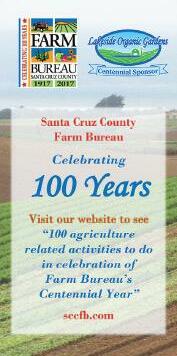



44 edible MONTEREY BAYSUMMER 2017
SEAWATER KIMCHI
Courtesy James Anderson, chef, Poke Lab in Monterey
Makes 10–15 servings
As I was working on this recipe, an old saying from the people in Provence and Northern Italy kept coming to mind, something like: ‘Nous avons la même mère,’ (we have the same mother, mère, and mer being the sea). It’s no secret that the ocean has provided life for the span of civilization, and yet we shy away from what those provisions actually are.

I adapted this recipe from a bit of trial and error, some input from Korean mothers and what was available at the farmers’ market immediately outside the restaurant. Apples from local trees, Purple Haze garlic, giant heads of Napa cabbage and the blistering hot Black Dragon chili sauce all lend unique flavor profiles. Using ocean water is such a natural fit. Using sea salt to brine the cabbage is common practice, so why not sterile ocean water with its salinity already available?
1 large or 2 medium (10 pounds’ worth) Napa cabbages, washed
1 gallon sterile, strained ocean water
2 bunches green onions, ends removed and sliced in 1-inch pieces
5 garlic cloves, peeled and chopped
1 pound sweet apples (Pink Lady or Fuji work well), quartered and seeds removed
1 yellow onion, peeled, halved and chopped finely 2-inch piece of firm ginger, peeled, cut in small rounds and crushed ¾ cup favorite type of fish sauce or anchovy patis ¼ cup Red Bird chile, finely chopped, or Korean chili powder (to taste)
Note: I don’t use sugar in this recipe, allowing the apples to act as sweetness to ferment later.
Remove the outermost leaves of the cabbages until only firm leaves remain. Quarter smaller heads or cut into 2-inch chunks. Place in a clean large bowl with high sides or a clean food-grade bucket. Add half of the water over top, and then press into the cabbage, massaging the seawater into the leaves as they tenderize, about 3–5 minutes. Place a heavy plate, which fits inside, to weigh down the cabbage (two or three may be necessary). Add remaining water to cover. Allow to sit for 1 hour in a cool spot while preparing the final ingredients.
Combine the garlic, apples, onion, ginger and fish sauce in a food processor, pulsing until a purée forms. Set aside.
Drain water from cabbage and squeeze any excess water out. Dry the bucket and fill with cabbage and apple mixture. Add scallions and chile then carefully mix together, making sure all sides and inner leaves are coated with the mixture. Place into an opaque container and weigh down using plates again. e idea is to allow the natural liquids to cover the mix as it ferments.
Leave in a cool spot, away from light, lightly covered for 3–4 days. Check it daily to make sure it is submerged. After 3 days, place in a refrigerator. After 2–3 more days, it should start to sour. Personal preference determines how long you’ll want to use it, but at least for a few weeks it will be delicious.
www.ediblemontereybay.com 45


46 edible MONTEREY BAYSUMMER 2017
SEAWATER CARAMELS
 Courtesy Yulanda Santos, pastry chef, Aubergine in Carmel
Courtesy Yulanda Santos, pastry chef, Aubergine in Carmel
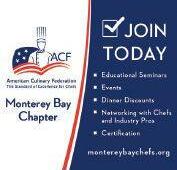
Makes about 300 60-gram pieces


When Yulanda and I worked together at the Post Ranch Inn we would occasionally use seawater in our recipes. I particularly loved this caramel recipe Yulanda came up with and asked her if I could include it in this article.
500 grams filtered seawater
800 grams sugar
660 grams corn syrup
500 grams heavy cream
160 grams butter

2 vanilla beans
Combine seawater, sugar and corn syrup in a saucepan. Cook on low heat to dissolve the sugar. en bring to a boil. Add the cream and cook approximately 3–4 minutes. Add in the butter bit by bit. Scrape vanilla beans then add to mixture. Cook, stirring constantly, until temperature reaches 248° F.
Pour onto a half baker’s sheet pan (about 13-by-18 inches) that has been lined with parchment paper and lightly buttered or coated with a nonstick spray. Cool completely or overnight before cutting.
www.ediblemontereybay.com 47
Monterey County has the highest proportion of undocumented residents of any county in the state— 13.5% of its population.
Meanwhile, in Santa Cruz County, an estimated 21,000 residents and 83% of farmworkers are undocumented.
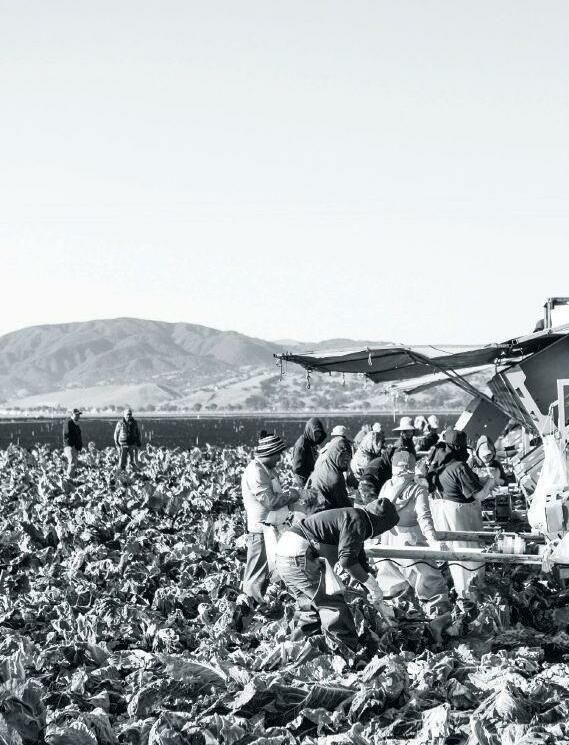
48 edible MONTEREY BAYSUMMER 2017
ON THE FARM FEAR IN THE FIELDS
Increased immigration uncertainty deepens problems for local farms and farmworkers
 BY ELIZABETH LIMBACH PHOTOGRAPHY BY MICHELLE MAGDALENA
BY ELIZABETH LIMBACH PHOTOGRAPHY BY MICHELLE MAGDALENA
For third-generation farmer Maria Inés Catalán, agriculture is her culture. e 55-year-old owner of Catalán Family Farm in Hollister is carrying on a tradition passed down from her grandfather, who was a farmer in Mexico, to her father, who came to the United States as a contract laborer in the 1960s, and mother, who worked in American fields for 30 years.
Catalán was the last in her family to immigrate to the United States from their home state of Guerrero, Mexico. en 25 years old, she worked for large ag companies picking vegetables like lettuce, spinach and peppers. Several years later, she and her siblings tagged along with their mother to a talk about organic agriculture, and Catalán was hooked: She embarked on a threeyear training program at the Rural Development Center (the predecessor to the Salinas-based Agriculture and Land-Based Training Association, or ALBA), learning everything from operating heavy machinery to pest management.
When Catalán started her farm in the late ’90s, she says it was unheard of for a Latina woman to go from agricultural worker to organic farm owner. e two decades since haven’t been easy—farming rarely is, and aside from surmounting the challenges of being a non-Englishspeaking woman farmer, she faces the problems that plague all local farms, large or small, such as reliance on an immigrant workforce at a time when immigration reform is desperately needed, the resulting field labor shortage, extreme weather and thin margins. But today she farms 14 acres (down from 80 after a catastrophic well accident in 2014), reaching consumers through farmers’ markets and a CSA program, and selling directly to local restaurants. It’s a family business, with her children and grandchildren now learning the ropes of sustainable agriculture.
Catalán believes that farming is a way to honor her heritage while providing healthy food to her community. But following the election last November of President Donald Trump, who had run on an antiimmigrant agenda, and the actions he has taken since then to pursue it, she has new worries not only for her own business, but also for the local community and food system. “When he became president, I spent
the whole night crying,” Catalán says, through an interpreter. And she’s seen her distress reflected in the farmworker community in the months since the president took office. “I see more people in fear, and I know farmworkers who have left [the country] willingly,” she says.
A CHANGED WORLD
It’s no secret that California’s multi-billion-dollar agriculture industry relies on a largely undocumented workforce—U.C. Davis estimates the total to be as high as 70%. But until January, few on the Central Coast gave it much thought.
e last few decades have been a time when government and employers tended to “look the other way,” says Doug Keegan, an attorney and the program director of Santa Cruz County Immigration Project (SCCIP) in Watsonville. “It was some kind of tacit understanding that immigration would not come to our region and conduct large-scale indiscriminate raids,” Keegan says. “I think everyone is of the opinion now that that deal is off—that at any time now, there could be the return of large-scale raids.”
Immediately after his inauguration, Trump followed through on campaign promises with a burst of executive orders aimed at cracking down on illegal immigration. Among the directives were pushes for an increase in border security—including construction of a wall and additional border agents; cutting federal funding to sanctuary cities (Santa Cruz and Monterey counties and the cities of Santa Cruz and Watsonville all have adopted sanctuary resolutions); an expanded definition of which undocumented residents are deportable; growing the ranks of Immigration and Customs Enforcement (ICE) agents; a freeze on refugee entry; and the so-called “travel ban.”
e already heated political climate became even more highly charged, and alarm spread through immigrant communities across the country—including in local fields. “ere is a lot of fear and panic in the farmworker community, especially here in the Pajaro Valley and Salinas Valley,” Keegan says.
www.ediblemontereybay.com 49
Catalán Family Farm’s Maria Inés Catalán
Photo this page by Leslie
David
Monterey County has the highest proportion of undocumented residents of any county in the state—13.5% of its population, according to the Public Policy Institute of California. Meanwhile, in Santa Cruz County, an estimated 21,000 residents and 83% of farmworkers are undocumented.
Concerns about the new administration’s immigration policies were amplified in February, when the Department of Homeland Security, in cooperation with the Santa Cruz Police Department, conducted a raid in Santa Cruz that captured gang members wanted for crimes. In the process—and unbeknownst to the SCPD, which has committed itself to not aiding immigration enforcement as part of Santa Cruz’s sanctuary status—undocumented residents not related to the investigation were also detained. “e raid that took place in Santa Cruz really increased the level of anxiety…and really created a lot of havoc,” says Keegan. “ere is concern about raids in the fields.” And these fears, sadly, may be causing this already vulnerable population to be too frightened to access basic services like health care and food assistance, or report crimes, putting it at even greater risk.
In the months following Trump taking office, SCCIP was flooded with hundreds of requests for guidance, legal advice and resources. Many of the families seeking assistance have been here for years, and often have mixed status, meaning, for example, parents are unauthorized but the children are legal residents. “ere is a lot of concern about what happens to their children if [the parents] are deported,” Keegan says.

Families are making sure their kids have passports and even liquidating their local assets, says Brett Melone, director of lending for California FarmLink. e organization, which connects independent farmers—including immigrants who began as farmworkers—with land, loans and business resources, is also waiting to see if it will be affected. “ere’s the issue of employing people who are undocumented, and then there’s the issue of lending to people who are undocumented,” Melone says. “e risk is slightly different, but it’s definitely something we have a heightened awareness about.”
Given the fact that immigration from Mexico has declined in recent years, and farms are already struggling to fill out their crews, the current administration’s approach to immigration could further handicap an already impaired ag industry—sending food prices soaring as a result. e good news is that this spring, the administration offered some promising comments about not targeting farmworkers with its enforcement actions. But thus far, the new cabinet’s aggressive anti-immigration policies and the absence of concrete new protections for farmworkers have at best confused the matter and at worst, contributed to a continuing decline in the farmworker population. Farms are holding a collective breath as they wait to see how they will be affected.
“Now is the time that a lot of the workers would normally return from Mexico to get started for the new season,” says Keegan, speaking in March. “Whether they’re able to return or not is a big question, given the increased security at the border.”
A PRE-EXISTING CONDITION
“It’s not just a Trump thing,” Jeff Larkey says on a bright March afternoon. “It’s something that’s been developing over some time.”
e farmer was seated under a shade structure in the center of the smaller of two properties that comprise Route 1 Farms, in Santa Cruz. It was the warmest day of the year so far—the last in a string of sunny days sandwiched between rainstorms—and the fields had finally dried enough to allow for planting. Larkey and his crew were racing to finish before the rain started again.
Larkey has been farming this land since 1981, when he and four friends each had an acre and a half. He’s the last farmer standing, and has seen his operation swell to 155 acres, in total, and then shrink down to its current 55. Sustainable farming is his calling—he says he can’t imagine doing anything else. But it’s becoming harder every year.
“It used to be that one out of every five or six years would be a bad year, depending on supply and demand, but now it seems like every other year is a battle just to break even,” he says. A labor deficiency is the main culprit: “Over the last five years, it’s been an increasingly difficult job to find enough farmworkers to do what needs to get done—what I mean by that is capable, professional farmworkers.”
California farms have been struggling with an increasingly dire worker shortage for several years. At the root is the lack of comprehensive immigration reform that would allow capable workers to come to the United States to work in the ag industry. ere’s the H-2A guest worker visa program, which has echoes of the beleaguered Bracero Program of yesteryear and is largely opposed by farmworker advocates and often spurned as too expensive and problematic by farmers. But an increase in border security, slowing of immigration from Mexico and spiking prices for border crossing—plus this area’s high cost of living and lack of affordable housing—have led to a drought of workers.
“We’re not getting an influx of new labor,” says Keegan. “People are really discouraged and prevented from entering.” A February piece about the California shortage in e New York Times reported that “the oncesteady stream of people coming from rural towns in southern Mexico has nearly stopped entirely.” Additionally, the fieldworkers who are here are aging, and it seems many of their children are not taking jobs in the fields.
“I think most farmers will say in private, ‘Yeah, we’ve got a problem here,’” Larkey says. “But they aren’t necessarily willing to say it in public. ey’re unwilling to speak out for fear of becoming a target or losing part of their workforce.”
50 edible MONTEREY BAYSUMMER 2017
Doug Keegan of the Santa Cruz County Immigration Project

www.ediblemontereybay.com 51
“We know on the Central Coast how important immigration is to this area—without immigrants the economy would be devastated and the Central Coast would almost shut down.”
—Rep. Jimmy Panetta
Photos this page and p. 48 and 54, farmworkers harvesting cauliflower at Tanimura & Antle
Exacerbating the problem, here in our nation’s Salad Bowl and berry epicenter, is that the crops are particularly labor intensive to produce. Immigration issues may threaten larger farms and those with unauthorized workers most, but this puts a squeeze on the already shrinking workforce—meaning farms must compete for fewer workers, and often come up short. e result includes unharvested fields, financial losses and shrinking production.
Last year, when it came time for Route 1 Farms to augment its year-round workforce with seasonal help, the labor was nonexistent. e farm wound up losing money. “ere were all these crops that just got swallowed up by the weeds,” Larkey says. “We couldn’t take care of and harvest them.”
is year, to cope with the new labor landscape, Larkey planned to cut back on production, concentrating on crops that he knows he’ll be able to handle. “Our farm is in jeopardy because of it, no doubt,” he says.
LEARNING TO ADAPT
e shortage has forced farmers to be more creative in their efforts to attract and retain workers, says Melone, with California FarmLink. “What we started hearing a couple of years ago was that farmworkers…had more control and power in the relationship than the grower because they had other options,” he says.
Farmworker wages in California have gone up 28% since 2010, according to the Employment Development Department. (And there’s a minimum wage increase and overtime bill in the works.) But raising pay alone won’t solve the problem, says Jim Bogart, president of the Salinasbased Grower-Shipper Association, which represents more than 300 member farms and other agricultural businesses on the Central Coast, providing them with legal services, advocacy, labor relations and human resources support, education and other assistance. “Here on the Central Coast, we pay the highest of the highest wages, and we’re still having trouble,” Bogart says. “ere’s just a smaller pool of workers to provide the labor.”

Tanimura & Antle, a large Salinas-based grower known for its lettuces and brassicas, fell short on harvest staff in 2015 despite paying workers an average of $16–18 per hour plus productivity bonuses. After failing to harvest 200 acres because of it, “we needed to make sure that didn’t happen again,” says COO Tim Escamilla.
For a solution, the farm considered turning to the H-2A temporary worker program, which it utilizes at its Yuma, Ariz., location. Employers are required to provide housing for H-2A workers, so, in preparation, T&A built a new housing development on its Spreckels farm called Spreckels Crossing. Much to its surprise, the complex turned out to be a draw for workers who were already in the United States: “What we found
was that once many of our domestic harvest employees who work with us in Yuma heard about Spreckels Crossing—and that it was new, comfortable, well-outfitted, safe and affordable—we started getting approached by people who wanted to come and work the Salinas season with us,” Escamilla says.
As a result, T&A was able to meet its 2016 needs without using the H-2A program after all. As of this writing, T&A expected to fill out its crews again this year with farmworkers already in the country.
Live Earth Farm in Watsonville, run by Santa Cruz Farm Bureau president Tom Broz, is a small grower of a diversity of organic crops, and has also struggled to find enough qualified labor.
Last year, several profitable but labor-intensive crops, including green beans and cherry tomatoes, were left unpicked in the fields. “It was stressful,” Broz says. “It’s difficult if you have a set marketing strategy to have to adjust mid-season. We tried to minimize our losses by focusing only on those crops we hoped would fetch the highest price in the marketplace.”
Broz made further shortage-driven changes this year, such as choosing to scale back on raspberries, which are handpicked and laborious. Also new this year, Live Earth began hiring seasonal workers in March—several months before it normally would—to guarantee it would have the help when it needs it. As in past years, the farm will hold U-picks aimed at bringing in customers to help with the picking of its tomatoes.
If the Salinas-based Western Growers Center for Innovation and Technology, in Salinas, has its way, automation will help solve the labor supply issue, which it frames on its website as a “man vs. robot” matter: “Will immigration reform be the answer to this problem or will robotic harvesting technologies be the future?”
Hank Giclas, senior vice president of strategic planning, science and technology at Western Growers, points out that mechanization has been successfully adopted in bagged greens and salads, and he believes that berries are next. “I see automated harvesting of berries in the nottoo-distant future,” he says.
But winning farmers over to automation, he says, could require them to adapt in ways they haven’t seemed willing to historically, such as changing what and how they grow. To help make the machines more accessible, he believes the industry may need to devise renting and sharing programs so that individual farmers will not have to buy the costly machinery.
Some California farmers are already finding relief in machines— take, for example, a fig, persimmon and almond farmer profiled earlier this year in the Los Angeles Times who bought $600,000 of equipment when Trump was elected. But automation still seems like a pipe dream to many other growers—especially smaller ones. e options that currently exist are not as cost efficient or quick as human labor, and many
52 edible MONTEREY BAYSUMMER 2017
From left, Tanimura & Antle’s Tim Escamilla and the Grower-Shipper Association’s Jim Bogart outside of T&As’ new farmworker apartments near Salinas.
farmers, including Larkey, are skeptical that automation could ever be the answer. “It’s not going to solve the problem,” says Larkey. “If it does, you’re going to cut out many small- and medium-sized farms— run them out of business. ey wouldn’t be able to mechanize. And that’s not a good thing because you want those farms that grow lots of different crops.”
is is exactly why there must be more research and development in this area, says Rep. Jimmy Panetta, who began representing the Central Coast in Congress in January following the retirement of Sam Farr. “e Salinas, Pajaro and San Juan valleys are all in the shadow of Silicon Valley, so we need to continue to build that bridge between our valleys and Silicon Valley,” the congressman says.
We’re lagging behind countries in Europe on the mechanization front because we’ve been able, historically, to rely on a workforce coming over our Southern border, he explains, adding that the United States may be forced to catch up given the changing political and socioeconomic atmosphere. “e immigration rate from Mexico has dropped, as you know, so who is going to fill that void?” he asks. “I do believe machinery can do that, but it’ll take investment.”
THE BIG PICTURE

When it comes to fixing the labor crisis, much of the ag industry sees immigration reform as the most crucial solution. “We’ve been in favor of comprehensive immigration reform since day one,” says Bogart, of the Grower-Shipper Association, “and as part of that reform, specifically with regard to agriculture, we need access to a legal and stable workforce.”
For farmers and the advocacy groups and legislators who support them, this means a few key reforms: legalizing the existing workforce and expanding, improving or replacing the temporary guest worker visa program, which Bogart describes as broken beyond repair. “at really needs to be fixed so that we have access to workers that would supplement our regular workforce at the time we need them and in the numbers we need them, without a bunch of bureaucratic red tape hoops to jump through,” Bogart says.
Bogart feels “hopefully optimistic” thanks to some assuaging comments out of Washington over the course of the spring. On April 25, President Trump issued an executive order aimed at improving agricultural and rural wellbeing that pledged to “ensure access to a reliable workforce and increase employment opportunities in agriculturerelated and rural-focused businesses.” A few days later, the newly appointed Secretary of Agriculture, Sonny Perdue, told a town hall in Kansas City that the ag industry shouldn’t be worried about the administration’s anti-immigration efforts.
"He understands there are long-term immigrants, [including] undocumented immigrant laborers, [and] many of them are doing a great job contributing to the economy of the United States," Perdue said, referring to Trump in his remarks at a town hall meeting sponsored by the Agricultural Business Council of Kansas City on April 28, according to a report by Southwest Farm Press.
Collectively, Bogart says these statements “give us encouragement that immigration reform—or at least something to address the farm labor shortage—is forthcoming.”
A partial solution may come in the form of immigration legislation introduced on May 3 by Sen. Dianne Feinstein (D-Calif.) and a
www.ediblemontereybay.com 53

54 edible MONTEREY BAYSUMMER 2017
handful of other democratic senators. Known as the Agricultural Worker Program Act of 2017, it would protect farmworkers from deportation efforts and provide a pathway to legal status and eventual citizenship. But while it does offer a way to safeguard the existing workforce, the bill does not address the need for guestworker program reform—and, in Bogart’s words, “We need both to fix the problem.”

e bill had yet to be voted on as of press time.

Meantime, Bogart’s organization is helping its members navigate the current situation. In May, for example, along with meetings on topics like healthy soils and food safety, the Grower-Shipper Association hosted an immigration law workshop on the topic of federal employment verification forms and “What to do When ICE Shows Up.”
Santa Cruz County Immigration Project’s Keegan is not so encouraged by the administration’s recent comments. “e increased security at the border means fewer workers will be able to travel to fill the jobs required by the ag industry,” he says. “Farmworkers will continue to fear deportation until there is concrete policy or immigration reform that protects them.”
And as for Feinstein’s proposed legislation, his hope is measured.
“e Agricultural Worker Program Act, if it passed and became law, would go a long way to easing the labor shortage in agriculture. But without bipartisan support, its chances of passage, like all immigration reform efforts in the past 30 years, are slim,” Keegan said in early May.
Meanwhile, the administration’s messages are mixed. ICE’s arrests of noncriminal immigrants have doubled under President Trump, as reported by e New York Times. On March 30, Attorney General Jeff Sessions told Fox News that noncriminal immigrants like farmworkers “is not where ICE is focusing its effort at all.” But soon after, on April 11, Sessions gave a tough-on-immigration talk at the border, stating, among other things, that individuals who re-enter the country will now be charged with a felony, rather than a misdemeanor—effectively making returning undocumented farmworkers and other immigrants into criminals, and therefore subject to deportation.
“Employers want more than empty or sometimes contradictory promises,” Keegan says. “ose employers need a stable and experienced labor force that will not be targeted by an administration whose focus is deportations.” Even if the administration doesn’t directly target farmworkers—no raids in the fields, for example—policies like increased border security and targeting sanctuary cities could still put a strain on the farmworker population, thus weakening the already shrinking workforce. (Sessions himself has said that border entry is already down 60%, thanks to Trump.)
e silver lining of the roiling immigration debate is that it’s finally being discussed, says Live Earth Farm’s Broz. “Maybe it takes an administration like the one we have right now to [make people] realize
what’s at stake,” he says. “[Maybe] enough people will put pressure on elected officials to implement comprehensive immigration reform. ings might come to a head where things have to get done.”
e trick in getting the new administration’s ear, says Panetta, will be to drive home the economic argument—that the Central Coast’s $9 billion ag and nearly $3 billion hospitality industries, for instance, are inextricably linked to immigrant labor. “We know on the Central Coast how important immigration is to this area—without immigrants the economy would be devastated and the Central Coast would almost shut down,” Panetta says.
“First thing is you’ve got to get Donald Trump out to the district, out to the fields,” Panetta continues. “is is a guy who grew up in Queens, who lived in a golden tower. e last person he picked in his cabinet was the secretary of agriculture. In the budget he put forward, he wants to cut 21% from the USDA. We need to speak to him on economic terms and let him know that the food he eats doesn’t just come from the store, but it comes from the fields. And in order to get from the field into your mouth, it takes people—especially with our specialty crops on the Central Coast.”
Reckoning with immigration in agriculture requires everyone to care about where his or her food comes from and how it got to them, says Broz. After all, everyone—no matter their politics—needs to eat.
“There is a disconnect that I feel we have between consumers and food producers [where] many people don’t trust or don’t even understand what it takes to bring food to your plate,” he says. “It’s a long-term effort to close this gap and we all need to pitch in, because down the road we will face more and more issues—whether it’s climate change, labor, all of those things. Ultimately we are all connected to agriculture because we all eat three times a day. We all have a stake in it."
For Catalán, the owner of Catalán Family Farms, the motivation for consumers—and for that matter, the president—to understand where their food comes from and in particular, the effect immigration policy has on food, is clear.
When asked what she would say to the president if she had the opportunity, she says, “Without Hispanics, there is no food for low-income people. Food prices will rise, and only the wealthy people will be able to afford it.”
www.ediblemontereybay.com 55
Elizabeth Limbach is a freelance journalist living in Santa Cruz, where she writes about culture, the food system, and the environment.
From left, Darryl Wong, UCSC/CASFS; Tom Broz, Santa Cruz Farm Bureau/Live Earth Farm; Rep. Jimmy Panetta, 20th District; Mark Lipson, UCSC/CASFS; Jeff Larkey, Route 1 Farms; and Brise Tencer, Organic Farming Research Foundation
EDIBLE ICONS ALAN CHADWICK

He wore his brave state out of memory
BY PAUL A. LEE PHOTOGRAPHY BY MICHELLE MAGDALENA
is summer marks the 50th anniversary of the UC Santa Cruz Farm & Garden, the heart of what would become the Center for Agroecology and Sustainable Food Systems, an internationally renowned leader in sustainable agriculture research and education. It was in 1967 that philosophy professor Paul Lee first envisioned a bountiful garden on campus, believing that the brand new university needed roots. Lee—who later went on to start the California Conservation Corps with Governor Jerry Brown and the Homeless Garden Project in Santa Cruz—hired English master gardener Alan Chadwick to create the garden. Edible Monterey Bay is delighted to publish Lee’s tribute to an extraordinary man.
He was called “the wizard” by radical philosopher Norman O. Brown, and referred to as such by avant garde composer John Cage, who went mushroom hunting with Alan Chadwick and then gave his mushroom reference library to UCSC because he was so enchanted by the man. A wizard he was although there are probably better terms to describe the charismatic power and influence he had on students who came under his spell.
It is 50 years since his arrival at the very moment when I had called upon Chancellor Dean McHenry to support a student garden for the campus in line with “flower power,” a popular slogan of the 1960s. e chancellor thought it was a good idea. And then came Chadwick as though he had dropped from the sky like Ziggy Stardust. We met at the Cowell College fountain and he said yes when I asked him if he would do our garden. e next day he went out and bought a spade and picked out the slope below Merrill College and started to dig. e rest is history.
Chadwick reintroduced “organic” under the theme of French intensive and biodynamic food and flower production, both of which eschewed the use of chemical fertilizers and pesticides. No more industrial society procedures heralded as “better living through chemistry.” I knew we were living in a historical period defined as the late stage of the self-destruction of industrial society; I and others wanted out. Chadwick showed us a way.
Here’s how it goes. Organic nature was supplanted by organic chemistry in the early part of the l9th century through the artificial synthesis of urea. It is a date you should know—1828. Friedrich Wöh-
56 edible MONTEREY BAYSUMMER 2017
And then came Chadwick as though he had dropped from the sky like Ziggy Stardust.
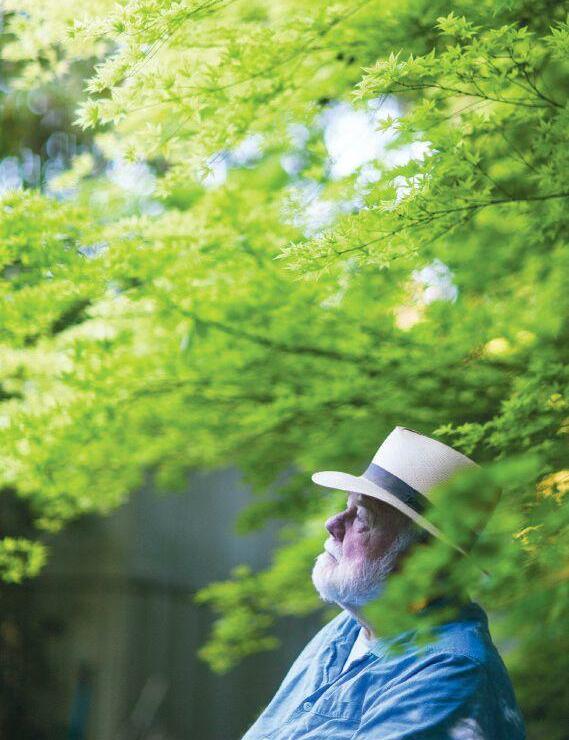
www.ediblemontereybay.com 57
ler artificially synthesized urea by heating up ammonium cyanate and getting what he thought was the same substance the kidney produced—urea—the nitrogen part of urine. It made great fertilizer and was the basis for the plastics industry (poly-ure-thane). e move was made from the field to the lab. It didn’t take long before factories were called plants! And so we got industrial society as a world superior to the given world of nature. Organic became a thing of the past—after all, chemicals were chemicals when you reduced everything to matter, which is exactly what reductionist physicalist science has done. So what’s the big deal? e long dislocation from reality had begun. Artificial, synthetic, virtual, imitation, simulation, like… Count how many times you hear “like” in conversations today and think of it as the expression for the dislocation.
So organic had to be re-discovered and re-affirmed and that’s what Chadwick brought to the campus and eventually to the region.
Moreover, he brought a reverence for nature that students were looking for. You might even call it sacramental. A lot of them had seen eternity in a grain of sand thanks to LSD. ey had undergone a transformation of consciousness and Chadwick was the mentor who would show them a new way in his reliance on strictly organic procedures, in his relation to creation. He espoused an organic worldview. I guess you could call it neo-vitalist where life was honored and respected and nurtured.

He introduced me to an economy of gift. Everything he grew he gave away and never wanted money. He hated the commercialization of food production as much as he hated mono-cropping and machines. He did hand work. He was an original artisan when it came to gardening. An economy of gift. What a nice ring to the phrase. It meant relying on the abundance nature provides—the principle of plenitude. Give and more will be given to you, pile it up and let it spill over your lap. I came to call it too much zucchini.
Ah, Chadwick, you were as much a trial as you were a gift, thanks to your awful temper tantrums left over from your experience on a minesweeper in the second World War. I was always willing to forgive your neurasthenia, and you taught me the difference between idiosyncratic display and institutional process. You were a forced fit when it came to the university, and it showed in the force of your fits.
And then it was over; short lived, when you think of the couple of years involved. But what an impact Chadwick made. I have an orotund way of putting it: He replanted the vital root of existence in the
58 edible MONTEREY BAYSUMMER 2017
He replanted the vital root of existence in the late stage of the self-destruction of industrial society
late stage of the self-destruction of industrial society as a world above the given world of nature. Yes, he did.
His influence was enormous. I think of the students who went on to become gardeners and farmers and carried on the organic lifestyle Chadwick revealed to them; Alice Waters and Chez Panisse; my nephew, Ben Ford, and his Chadwick restaurant in Santa Monica; Baker Roshi, who took Chadwick in after he left UCSC and had him start the Zen Center Farm at Green Gulch; Jerry Brown, during his first stint as governor, waiting to go in to hear Chadwick on his deathbed at Green Gulch Farm; Richard Wilson and the garden at Covelo; Betty Peck and the garden at Saratoga. ey all testify to the magic and mystery of this man and his devotion to nurturing the earth and reaping its harvest.
How I wish I could hear him tell again and act out the nuptial flight of the queen bee and the fairy tales of the herbs, rosemary and

UC Santa Cruz will hold a three-day First Fifty Celebration of the garden anniversary on July 28–30. It includes an opening reception on Friday evening, a Saturday morning Fog Rise gathering at the Alan Chadwick Garden, a symposium with urban farming guru Karen Washington, a banquet in the Hay Barn with Alice Waters, guided tours and gardening workshops. For more information, see the website: www.casfs.ucsc.edu/about/50th/events.html.

calendula. We cherish your memory Alan, and all you gave to us; our gratitude knows no bounds.
Chadwick put Shakespeare’s Sonnet 15 on the wall next to his bed before he died. Shakespeare composed it for him:
When I consider every thing that grows Holds in perfection but a little moment, at this huge stage presenteth nought but shows Whereon the stars in secret influence comment; When I perceive that men as plants increase, Cheered and cheque’d even by the self-same sky, Vaunt in their youthful sap, at height decrease, And wear their brave state out of memory; en the conceit of this inconstant stay Sets you most rich in youth before my sight, Where wasteful Time debateth with Decay, To change your day of youth to sullied night; And all in war with Time for love of you, As he takes from you, I engraft you new.
Paul A. Lee is a retired professor of philosophy, religious studies and the history of consciousness and an Episcopalian-Lutheran pastor. He is also the visionary creator of several community activist organizations and remains an engaged leader of two of them, the Homeless Garden Project and the Association of Faith Communities of Santa Cruz County.
www.ediblemontereybay.com 59
THE PRESERVATIONIST INDIAN PICKLES
e secret to preparing authentic Indian cuisine
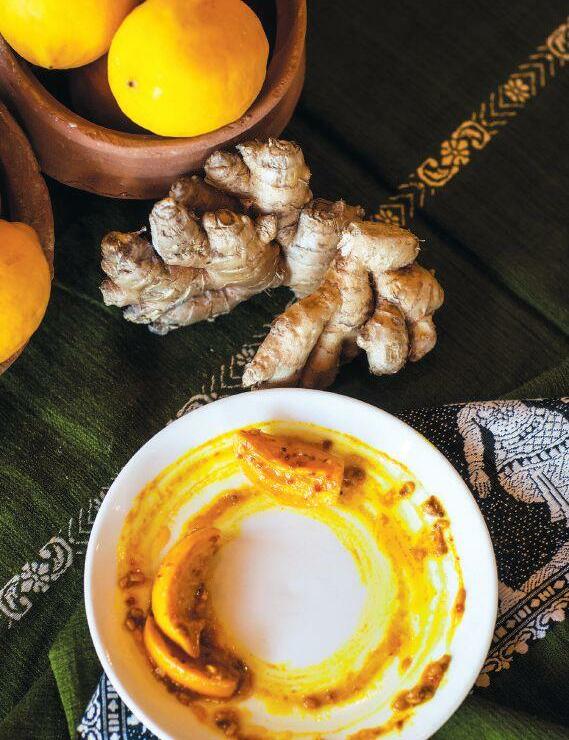 BY JORDAN CHAMPAGNE PHOTOGRAPHY BY MARGAUX GIBBONS
BY JORDAN CHAMPAGNE PHOTOGRAPHY BY MARGAUX GIBBONS
60 edible MONTEREY BAY SUMMER 2017
Home-cooked Indian cuisine can be an intimidating concept. To begin with, cracking the code to combinations of unique spices that most Westerners have never heard of—ingredients like fenugreek, asafoetida (the root of a plant similar to wild fennel, used powdered) and ajwan (tiny berries somewhat like coriander that add bitterness)—can be a daunting task. Even the flours have different names. And often it seems that cooking an authentic Indian meal demands a trip to a specialty grocery store in San Jose—where the largest population of Indians outside of India resides. It’s a great resource, but feels like a long way to go to procure ingredients for dinner. ere is one trick, however, that can make your meal taste like the real thing without too much fuss: Serving Indian pickles will add authentic flavor to even a simple meal of basmati rice and dal.
Pickles are an essential part of any Indian platter and are served as a condiment with most meals on the subcontinent. ey have an intense flavor and can add an explosion of true Indian taste to your table. A friend who went to boarding school in India says she loved how everyone would bring a jar of homemade pickles at the beginning of each semester and she would be able to try pickles from every region. It was a cultural experience every time she ate.
You may purchase a variety of pretty good pickles at an Indian grocery store, providing you with a good place to start to acquire a taste for the strong spices and salt typical of Indian cuisine. One of my favorite markets is the New India Bazar in Santa Clara, which stocks a good selection of organic bulk items and exotic produce. It can feel like a quick trip to India with the colors, smells and the long checkout queue that snakes through the store. I’m usually the only non-Indian there.
Depending on the region and the season, Indian pickles are made out of all sorts of fruits and vegetables that do not grow in North America, such as amla fruit. But one of my favorite kinds of Indian pickle is made with lemons and is a standout. It is sort of a distant cousin to Moroccan preserved lemons as they are both cured with salt, but that is just the beginning.
Interestingly, Indian pickles are the only pickles in the world that are cured in direct sunlight. e sun helps break down the hard fruit or vegetables and encourages the oils to penetrate the surface. ere are a lot of recipes out there for quick Indian pickles, but one should not be tempted to take these shortcuts. It takes time to really develop the sourness of the pickle that balances the flavors of spicy, salty, bitter and sweet. ey are all there if you give them enough time to develop. Patience is a quality accordant with the authentic Indian experience.
Jordan Champagne is the co-owner and founder of Happy Girl Kitchen Co. in Pacific Grove and last year took a one-month sabbatical in India, where she practiced making pickles and learned to prepare delicious Indian dishes that she shares at occasional pop-up dinners and cooking workshops.
INDIAN LEMON PICKLES
Courtesy Jordan Champagne, proprietor, Happy Girl Kitchen Co. in Pacific Grove

Makes about 3 cups
When I was first learning to make Indian pickles I quickly realized that there is no standard way. It seems every household uses a different technique. I have developed a method that maintains the fresh flavor of the lemons and adds a strong combination of exotic spices. ese pickles are sure to add a bang to any dish! ey will last years on the shelf when cured properly.
4 lemons (any variety)
1 tablespoon dried chiles (or 3 fresh chiles) ¼ cup of fresh ginger, peeled and grated 2 tablespoons turmeric 1 tablespoon fenugreek seeds 1 3 cup pure sesame oil (not toasted) 1 teaspoon mustard seeds 2 tablespoons salt 1 teaspoon asafoetida
Slice lemons into quarters and remove as many seeds as possible (if a few slip by, it is OK). en slice each quarter into three. Add the salt to the lemons and mix thoroughly. Next, dry roast the fenugreek seeds and grind into a powder (I use a coffee grinder that I designate for spices or you can use a mortar and pestle). Add the fenugreek to the lemons.
Finely chop the ginger and chiles, if using fresh chiles. Heat oil in a tiny pan. Traditionally a kadi is used, which is a small cast iron pan. Add mustard seeds to the oil and once they start popping, add the asafoetida, turmeric, chiles and ginger. Cook for 2 minutes and then remove from heat and let cool. Add to the lemons and completely mix in.
Place the lemons in a quart-sized jar and cover with a loosely fitting lid or cheesecloth. Put jar somewhere in the house with direct sunlight. Shake the contents of the jar every day to mix thoroughly. Pickles should be ready in 1 month, or when the flavors are completely enmeshed in one another. e pickles will keep for 1 year out of the fridge, but can be refrigerated once you start using them.
www.ediblemontereybay.com 61
Indian pickles are the only pickles in the world that are cured in direct sunlight.
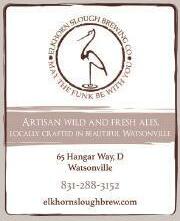
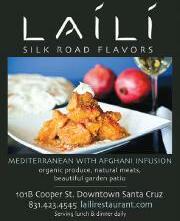
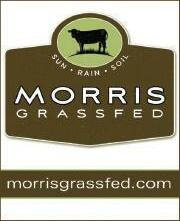
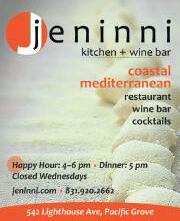
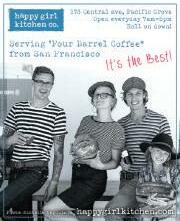
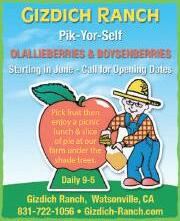


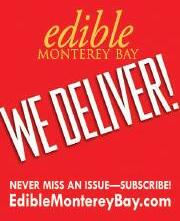
62 edible MONTEREY BAY SUMMER 2017 MONTEREY BAY MARKETPLACE • MONTEREY BAY MARKETPLACE
Dine Local GUIDE
APTOS
Carried Away
7564 Soquel Drive • 831.685.3926 www.carriedawayfoods.com

A cozy, green-certified, take-out or eat-in café, Carried Away has a menu that changes weekly and features primarily organic, locally sourced ingredients. Owner/chef Tom McNary worked for many years at Chez Panisse, and his dishes reflect the seasons. Soups, salads, entrées and desserts are all made freshly daily. in-crust pizzas available on Tuesday, Friday and Saturday. Open M–F 11am–7pm, Sa 11am–5pm, Su closed.

BIG SUR
Sierra Mar at Post Ranch Inn
47900 Highway 1 • 831.667.2800
www.postranchinn.com

Executive chef Elizabeth Murray and executive pastry chef Ben Spungin use exceptional ingredients, many grown on site, to deliver a unique gastronomic take on the Big Sur experience. Dinner features a 4-course prix fixe menu and the 9-course Taste of Big Sur tasting menu; lunch offers 3-course and 5-course options. Choose from almost 3,000 different wines from the Wine Spectator Grand Award winning wine list. Arrive before sunset for breathtaking views from this iconic restaurant’s floor-to-ceiling windows and cliff-side terrace. Open daily for lunch 12:15–2:30pm, dinner 5:30–9pm.
CAPITOLA
East End Gastropub

1501 41st Avenue • 831.475.8010 www.eastendgastropub.com
East End Gastropub is the newer baby sister to the popular West End Tap & Kitchen, but aside from sharing owners and chefs, East End’s beautiful, recently renovated modern interior is entirely different from West End and offers its own robust, sophisticated, beerfriendly menu. Chef Geoffrey Hargrave has created dishes that are familiar yet innovative, such as the “Kentucky fried” duck leg or the quinoa crusted Fijian albacore. e restaurant also offers its own brews, along with local rotating taps and a strong wine list. Open daily 11:30am–10pm.
e
Penny Ice Creamery

820 41st Avenue • 831.204.2523
www.thepennyicecreamery.com
Open Su– noon–9pm, F–Sa noon–10pm
See e Penny description under Santa Cruz for more.
Shadowbrook
1750 Wharf Road • 831.475.1511
www.shadowbrook-capitola.com
A Santa Cruz County landmark since 1947, the worldfamous Shadowbrook continues to be an overwhelming favorite with locals and visitors alike. Its fine food, extensive wine list and unparalleled setting and ambiance have earned it numerous awards, including Northern California’s “Most Romantic Restaurant” and “Best Date Night Restaurant.” Gift cards and reservations available online. Open M–F 5–8:45pm, Sa 4:30–9:45pm, Su 4:30–8:45pm.

www.ediblemontereybay.com 63
All of these restaurants emphasize local ingredients, and they also advertise in Edible Monterey Bay! Stop by for a free issue, and tell them that we sent you!
Jacks Monterey at the Portola Hotel & Spa has been remade with a whole new approach to its cuisine and new décor to match. For more, see p. 67.
Photo by Camilla M. Mann
CARMEL
Andre’s Bouchee

Mission Street between Ocean and Seventh avenues 831.626.7880 • www.andresbouchee.com
Chef Benoit Petel utilizes the bounty of the Monterey Bay with the best seasonal ingredients in the classic and creative French cuisine he prepares at this warm and elegant restaurant in downtown Carmel. Standouts include Monterey abalone with gnocchi, wild mushrooms and seaweed; escargot with garlic parsley butter, hazelnuts and puff pastry; and a classic duck confit with lentils. Petel works with Colleen from Savor the Local and the Monterey County Farmers’ Markets to obtain the freshest ingredients. Open for lunch F–Su noon–2pm and nightly for dinner 5:30–9:30pm. Wine tasting F–Su noon–5pm. Wine hour menu served at the bar Su– 5:30–7pm.
Aubergine
Monte Verde Street at Seventh Avenue • 831.624.8578 www.auberginecarmel.com
Located within the romantic L’Auberge Carmel, a visit to Aubergine feels like a trip to Europe. Executive chef Justin Cogley was named one of Food & Wine’s best new chefs of 2013. He has been nominated multiple times for a James Beard award and it’s no wonder—he’s an eloquent and imaginative interpreter of fine seasonal ingredients. Executive pastry chef Yulanda Santos delights with stunning and inventive desserts. Open daily 6–9:30pm.
Basil Seasonal Dining

San Carlos Street between Ocean and Seventh avenues (Paseo Courtyard) 831.626.8226 • www.basilcarmel.com
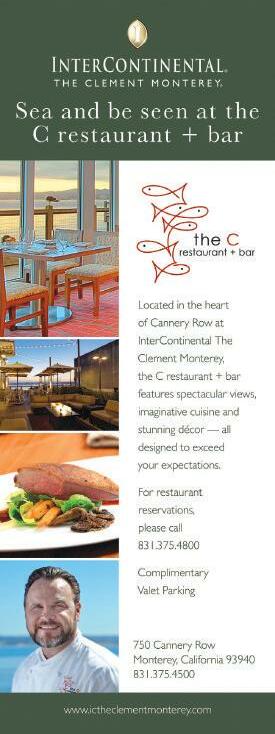
“Organic, local and seasonal” are not just buzzwords at Basil. is cozy restaurant in the Paseo Courtyard was awarded three stars from the national Green Restaurant Association. General manager/owner Denis Boaro and chef/owner Soerke Peters turn out intensely flavorful dishes and provide a full bar with a great selection of California wines. Many vegan entrées available. Heated, dog-friendly outdoor seating. Open daily for lunch and dinner from 11:30am, Su brunch 11am–3pm.
Cantinetta Luca


Dolores Street between Ocean and Seventh Avenue 831.625.6500 • www.cantinettaluca.com
Prepared in the Tuscan tradition, using the freshest and simplest ingredients sourced locally or imported from Italy, this authentic Italian eatery serves housemade breads, pastas and sauces, hand-cut premium meats and antipasti with the restaurant’s artisanal salume. Guests are served in an atmosphere of warm tones and dark woods, which invites lingering over a second glass of wine or another bite of tiramisu, apple crostata or cheese. Dinner Su– 5–9pm, F–Sa 5–10pm; Lunch F–Su noon–3pm.
Carmel Belle

Doud Craft Studios
San Carlos Street at Ocean Avenue 831.624.1600 • www.carmelbelle.com
is bright, airy restaurant is a favorite gathering place for anyone looking for a casual atmosphere and a stellar breakfast, lunch or dinner. e chefs here source only the best local and organic ingredients for their seasonally driven menu. Sign up online to receive Belle’s pop-up calendar and to hear about its special events. Enjoy your meal next to the fire pit or take advantage of the curbside pickup service to take it home. Open W–Su 8am–8pm, M–Tu 8am–5pm.
64 edible MONTEREY BAY SUMMER 2017
Earthbound Farm’s Farm Stand Organic Kitchen

7250 Carmel Valley Road • 831.625.6219 www.ebfarm.com/ourstory

At its Carmel Valley Farm Stand, Earthbound Farm’s certified organic kitchen delights with housemade soups, sandwiches, baked goods and an expanded salad bar. Experience picturesque Carmel Valley as you stroll through Earthbound’s organic gardens and learn about its pioneering local heritage and commitment to organic integrity. Food is available for take-away or a relaxing afternoon at tables in the gardens. Groceries also are available for replenishing your pantry. Watch Facebook for special events and classes! Open M–Sa 8am–6:30pm, Su 9am–5:30pm.
Edgar’s at Quail

8000 Valley Greens Drive 831.620.8910 • www.quaillodge.com
Taste the fresh ingredients harvested from local organic farms that are hand selected by Edgar’s executive chef Brian Kearns and exquisitely prepared by his culinary team into the savory dishes available on its new menus. Set in the clubhouse of Quail Lodge & Golf Club, Edgar’s restaurant and bar features a casual elegance with its indoor and outdoor fireside dining located alongside the natural backdrop of the golf course and Santa Lucia Mountains. Edgar’s at Quail is proudly guided in the principles of sustainability by the Monterey Bay Aquarium Seafood Watch and focuses on local farm-to-table options. Open daily 11am–9pm.
Il Grillo
Mission Street between Fourth and Fifth avenues 831.238.9608 • www.ilgrillocarmel.com


e intent behind this sister restaurant to Carmel’s popular La Balena is to create a more casual spot where diners can gather for a glass of wine, simple pastas and small plates. Enjoy a housemade Italian cookie or dessert after your meal, or put in an order to bring some treats home. Prices are also lower than at La Balena, but the same chef is creating the dishes, so expect impeccable sourcing and delicious results. Garden seating available. Open M–F 11:30am–9pm, Sa 5–9pm.
La Balena

Junipero Street between Fifth and Sixth avenues 831.250.6295 • www.labalenacarmel.com
Winner of EMB’s 2014 Local Heroes award for Best Chef/Best Restaurant, La Balena has a seasonal menu that changes daily but always expresses an inventive take on the rustic food of a Tuscan trattoria. e outstanding culinary team sources ingredients from local organic farms and prepares the restaurant’s pastas and slowcooked meats from scratch daily. Owners Anna and Emanuele Bartolini have created an excellent Italian wine list and a warm, inviting atmosphere, complete with back garden seating. Open Tu–Su 5–10pm.
CARMEL VALLEY
Lokal/Cachagua General Store
13762 Center Street 831.659.5886 (Lokal)/831.659.1857 (CGS) www.lokalcarmel.com

Father and son Michael and Brendan Jones are now under one roof with the relocation of Michael’s legendary Monday night dinners, known as the Cachagua General Store, to Brendan’s Lokal restaurant in Carmel Valley Village. e two restaurants will continue to operate independently, both of them emphasizing local and organic ingredients but each remaining the exuberantly creative

65
www.ediblemontereybay.com
and distinct foodie oasis regulars have come to know and love. CGS is open 10am–12:30pm on Sundays and 6pm–midnight on Mondays. Lokal’s hours are 10am–2:30pm on Saturdays and 6pm–closing –Su.
Lucia Restaurant & Bar


Bernardus Lodge & Spa • 415 W. Carmel Valley Road 831.658.3400 • www.bernarduslodge.com/wine-cuisine Indulge in artisanal California country cuisine, awardwinning wines and an expansive heated outdoor terrace with the finest views of all Carmel Valley restaurants at Lucia Restaurant & Bar. Named for the Santa Lucia mountain range and wine appellation that beckons to the south, renowned chef Cal Stamenov serves both his signature tasting menu and dishes à la carte. Wine list is equally notable. A private Chef’s table and wine cellar also available. Open daily 7am–2:30pm and 5–10pm.
Trailside Café and Beer Garden

3 Del Fino Place • 831.298.7453 www.trailsidecafecv.com ose needing to refuel after a day on the trail can head to Trailside Café for home-cooked meals in Carmel Valley. Beer lovers get to choose from 16 on tap, and sports fans can watch games on the HDTVs. Locals are treated to specials on Mondays and Tuesdays. On the weekends enjoy live music in the beer garden. Check out the calendar on its website for more details. Dog friendly in outdoor areas. Open daily 8am–9pm.
DAVENPORT
Whale City Bakery

490 Highway 1 • 831.423.9009 www.whalecitybakery.com
Davenport’s artistic charm and oceanside location make it hard not to slow when you pass through on Highway 1. ose in the know always stop at the historic Whale City Bakery. e bakery tempts with housemade breads, pastries, muffins and pies—and that’s only the beginning! Whale City also offers a full restaurant that serves up comfort classics and other hearty dishes. e bar and live music every ursday attract a loyal local following. Open daily 6:30am–8pm.
FELTON
e Cremer House

6256 Highway 9 • 831.335.3976 www.cremerhouse.com

Housed in the oldest building in Felton, e Cremer House showcases progressive, made-from-scratch food and drinks with a nod to its historic mountain surroundings. is alehouse has filled a niche in the San Lorenzo Valley, bringing to this restored and revered property craft beer, cider and wine on tap, and combining it with organic and sustainable fare made with local ingredients. Open Tu–, Su 11:30am–9pm, F–Sa 11:30am–9:30pm.
HOLLISTER
Grillin & Chillin Alehouse and Brewery

401 McCray Street, Suite B24 • 831.637.2337
Grillin & Chillin’s downtown location with an on-site brewery is your go-to spot for a burger and beer. With 40 craft beers on tap and just as many in bottles, there’s something for everyone. A favorite spot among bikers and other Hollister locals, the alehouse has a friendly and knowledgeable staff that can help you pick a pint from the long list of brews. Open Su–W noon–10pm, –Sa noon–11pm.
66 edible MONTEREY BAY SUMMER 2017
Grillin & Chillin Roadhouse

3650 San Juan Road • 831.636.1010

www.relaxgrillinchillin.com
Grillin & Chillin’s Roadhouse location is your stop for steaks, burgers, craft beer, and whiskey. With 30 beers on tap (including many locals brews), 100 more in bottles, and a long list of small batch bourbon and whiskies, there are plenty of options to help wash down your fish tacos, Cowboy Burger or 16-ounce bone-in ribeye named the “Tomahawk.” Catch the game on one of the 5 TVs or relax on the covered patio. Open Su– 11:30am–9pm, F–Sa 11:30am–10pm.
MONTEREY
e Club Room
2 Portola Plaza 831.649.2698
www.portolahotel.com/dining/the-club-room
e Club Room offers a fresh, seasonal, buffet featuring made-to-order omelets, assorted housemade pastries and muffins, sliced cold cuts, fine artisan cheeses, bottomless mimosas and much more. Dine in the cozy fireside dining room, or breathe in the fresh coastal air on the outdoor, pet-friendly, heated patio. Open for breakfast daily 6–11am.
e C restaurant + bar

InterContinental e Clement Monterey 750 Cannery Row • 831.375.4500 www.ictheclementmonterey.com
Step into the C restaurant + bar, and the bustle of Cannery Row will seem like a world away. Elegant yet relaxed, the C offers stunning ocean views from its floor-to-ceiling windows and oceanside deck; Executive Chef Matt Bolton provides equally gorgeous food, imaginatively prepared from sustainably sourced seafood, meats and produce. Creative cocktails include a design-your-own Bloody Mary, as well as sparkling wine flights from around the world. Open daily 6:30am–10pm, Happy Hour 4–7pm Su–. Live Music F–Su noon–3pm, –Sa 6–9pm.
Jacks Monterey
2 Portola Plaza 831.649.7830 • www.jacksatportola.com

Jacks Monterey offers “California Cultural Cuisine” and seats guests beneath the trees in a glass-topped atrium where they can enjoy the sun by day and the stars at night. Reflecting the palette of the Monterey Peninsula, the new space is decorated with ocean blues, driftwood browns and the greens of coastal flora. Chef Danny Abbruzzese’s new seasonal menu provides a melting pot of flavor profiles from the entire California coastline and other exotic locales. Creative spins on cultural dishes with locally sourced ingredients include Goat Moussaka and Hamachi Crudo. Open for lunch daily 11:30am–4pm; Dinner daily 4–11pm.
Peter B’s Brewpub
2 Portola Plaza 831.649.2699 • www.peterbsbrewpub.com

Experience Monterey’s original craft brewery, Peter B’s Brewpub, located behind the Portola Hotel & Spa. Enjoy great food and award-winning handcrafted beers. Watch your favorite game on one of 18 HDTVs or enjoy the pet-friendly heated patio with fire pits. Peter B’s is open daily with nightly Happy Hour from 4–6:30pm. Open Su 11am–11pm, M– 4–11pm, F 4pm–12am, Sa 11am–12am.

www.ediblemontereybay.com 67
e
Poke Lab

475 Alvarado Street 831.200.3474 • www.thepokelab.com
Serving fresh, light and sophisticated fast food made from local, sustainable ingredients, e Poke Lab has revamped the Monterey lunch scene. ree signature bowls include two with a variety of fresh tuna and salmon and one vegetarian option. Build the rest of your bountiful meals with a choice of a rice or salad and varied toppings and sauces. Sushi burritos are also available; order online for quickest pick-up. An official Seafood Watch partner restaurant, e Poke Lab serves only seafood rated sustainable. Open M–Sa 11am–8pm. Follow instagram for Wednesday’s food truck mobile locations.
Schooners Coastal Kitchen & Bar
400 Cannery Row • 831.372.2628 www.schoonersmonterey.com
Sit out on the oceanside patio if you can, but it’s still considered seaside dining if you are seated inside the dining room, whose polished wood, bay windows and seafaring décor seem like the interior of a sailing ship.
Schooners Coastal Kitchen & Bar serves executive chef James Waller’s sustainable seafood and prime steaks. e restaurant takes a creative Californian approach to soups, fresh salads, sandwiches and wood-fired flatbreads, paired with a diverse wine list featuring local favorites. Open daily 6:30am–11pm.
Stone Creek Kitchen

465 Canyon del Rey Boulevard • 831.393.1042 www.stonecreekkitchen.com
A glass-walled kitchen in the middle of a spacious cookware and tabletop shop turns out imaginative Mediterranean deli treats and sweets to take away or eat under the market umbrellas outside. Sandwiches, salads and entrée options change seasonally. Don’t miss Paella Fridays! Cooking classes, tasting events and dinner parties are hosted in the intimate teaching kitchen. Find a schedule of upcoming events on the website. Open M–F 10am–7pm, Sa 10am–4pm, Su closed.
TusCA Ristorante

Hyatt Regency Monterey Hotel & Spa
1 Old Golf Course Road • 831.657.6675 www.hyattregencymonterey.com
Blending the beauty and bounty of Tuscany and California, and inspired by the hearty appetite and abundance of southern Italy, TusCA serves up seasonally sourced menus made from fresh, local produce, meats and fish. TusCA chef Steve Johnson delights diners with meals both intriguing and indulgent, particularly those baked in his wood-burning oven or served with the housemade pastas. Open daily for breakfast and lunch 6:30am–2pm, dinner 5:30–9pm Tu–Sa.
e Wharf Marketplace
290 Figueroa Street at Wharf No. 2 and Del Monte Avenue 831.649.1116 • www.thewharfmarketplace.com


e Wharf Marketplace is Monterey’s newly remodeled, go-to fresh, local market with free 24-minute parking. Features the best-grown Salinas Valley lettuces and vegetables, artisanal cheeses, wines and draft beer. e Café & Grab-n-Go selections are designed to satisfy your cravings for every meal. Catering made easy for any staff breakfast or lunch and ready-to-take home dinners are sure to delight. Comfortable indoor/outdoor seating available. Open daily 5:30am–7pm; Taste It ursdays offer complimentary wine and beer tasting with onebite wonders 4:30–6:30pm.

68 edible MONTEREY BAY SUMMER 2017
MOSS LANDING
e Haute Enchilada
7902 Moss Landing Road • 831.633.5843 www.hauteenchilada.com

Gourmet Latin fusion dishes await those who venture off Highway 1 and into this fanciful restaurant with its large gallery out back that also serves as a venue for entertainment and private events. Fiesta-colored walls in the restaurant are adorned with enormous gold leaf paintings. Try dishes like Peruvian Ceviche, Squash Blossom Empanadas or the popular Pescado Cubano— line-caught red snapper in a pistachio/pumpernickel crust served with tomatillo avocado sauce. Ingredients are all natural, organic as much as possible. Open daily 11am. Last seating at 8pm.
PACIFIC GROVE
Happy Girl Kitchen Co.

173 Central Avenue • 831.373.4475 www.happygirlkitchen.com

e menu changes daily at Happy Girl’s airy and bright Pacific Grove café, but the food is always delicious, organic and reasonably priced. e sandwich of the day is $6.50, and a bowl of the soup of the day is $6. To drink, you’ll find kombucha on tap and freshly roasted Four Barrel coffee brewed to perfection. Homemade baked goods include a daily scone, cookies and turnovers. Open daily 7:30am–3pm.
Jeninni Kitchen + Wine Bar

542 Lighthouse Avenue • 831.920.2662 www.jeninni.com
Inspired by flavors of the Mediterranean, Jeninni Kitchen + Wine Bar’s rich and decadent cuisine takes you on a journey from Morocco and Spain to the Levant, birthplace of owner and sommelier, amin Saleh. Don’t miss chef Matthew Zimny’s crispy octopus, lamb burger with signature eggplant fries and occasional paella nights and other special events. Open Su– 4–9pm, F–Sa 4–10pm. Happy Hour—”sips and snacks”—4–6pm every day. Closed W.
Passionfish

701 Lighthouse Avenue • 831.655.3311 www.passionfish.net
If you’re looking for a restaurant with playful, spectacular food and a scrupulous commitment to sustainability, this green-certified restaurant is hard to rival. e elegant dining room is celebratory yet relaxed, and the award-winning wine list features many sustainable names and is priced at retail. Chef Ted Walter’s menu is ever changing with the seasons, but always includes delicious organic local produce, inventive slow-cooked meats and an array of sustainable seafood choices. Open daily 5pm.
Point Pinos Grill


79 Asilomar Boulevard • 831.648.5774 www.ptpinosgrill.com
With sweeping views of the coast and a relaxed clubhouse vibe, this scenic spot has blossomed under the direction of executive chef Dory Ford. For breakfast, choose from huevos rancheros, chicken fried steak and an array of tasty omelets. For lunch through dinner, enjoy dishes like Ale-Steamed Mussels and Crispy Fried Dry Rubbed Jerk Chicken Wings paired with craft beers, local wines or a house specialty cocktail. Open M–F 7:30am–8pm, Sa 7am–8pm, Su 7am–6pm. Happy Hour is M–F 4–6pm.
www.ediblemontereybay.com 69
PEBBLE BEACH
e Bench

e Lodge at Pebble Beach, 1700 17-Mile Drive 866.543.9318 • www.pebblebeach.com/dining
Overlooking the 18th hole at Pebble Beach Golf Links, e Bench at e Lodge at Pebble Beach delivers an eclectic menu inspired by international styles and methods, which uses the innovative technique of wood roasting and open-flame cooking. You can also enjoy one-of-a-kind craft cocktails, as well as an array of draft beers and wines by the glass. Open daily 11am–10pm.
Gallery Cafe
e Lodge at Pebble Beach, 1700 17-Mile Drive 866.543.9318 • www.pebblebeach.com/dining
Overlooking the first tee of Pebble Beach Golf Links, Gallery Cafe offers a wide selection of breakfast choices, from light smoothies to omelets and pancakes. For a casual lunch, try the excellent burgers or choose from a delicious selection of artisan sandwiches, plus the best milkshakes this side of the 1950s. Open daily 6am–2pm.
Pèppoli at Pebble Beach

e Inn at Spanish Bay, 2700 17-Mile Drive 866.543.9318 • www.pebblebeach.com/dining
At Pèppoli, the scents of Italian herbs and spices fill the air, and the décor transports you to a cozy Tuscan villa. e menu is big and bold, ripe with traditional pastas, seafood and meats. e extraordinary wine list is matched by equally impressive dishes, including delicious desserts, all with stunning views of Spanish Bay. Open daily 5:30–10pm.
Porter’s in the Forest
3200 Lopez Road • 831.622.8237 www.portersintheforest.com




A restaurant on a golf course, not a golf course restaurant. Chef Johnny De Vivo and his team have created a destination dining experience that has quickly become one of Pebble Beach’s top-rated restaurants on Yelp. Worried about driving on 17-Mile Drive? ey will reimburse you up to $20 if you take UBER transportation, which should cover round trip from almost anywhere on the peninsula. Open daily for breakfast and lunch and W–Su for dinner.
Roy’s at Pebble Beach
e Inn at Spanish Bay, 2700 17-Mile Drive 866.543.9318 • www.pebblebeach.com/dining
It’s all about big flavors and the gorgeous ocean view at Roy’s at Pebble Beach. Fresh seafood is front and center, where sushi, sashimi and blackened rare Ahi tuna are prepared to perfection, but many exciting meat dishes and island salads are also featured on the extensive Hawaiian-fusion menu. Add a dynamic wine list, exceptional desserts and an energetic environment, and you have one impressive dining experience, all overlooking Spanish Bay. Open daily for breakfast 6:30–11am, lunch 11:30am–5pm, dinner 5:30–10pm.

70 edible MONTEREY BAY SUMMER 2017
Stave Wine Cellar at Spanish Bay
e Inn at Spanish Bay, 2700 17-Mile Drive 866.543.9318 • www.pebblebeach.com/dining
A combined wine lounge and retail shop, Stave Wine Cellar is a luxurious yet casual space that is ideal for special wine dinners or gathering with friends and colleagues. You can pair varietals by the glass with a menu of cheese and charcuterie plates. In addition to nearly 30 wines and eight craft beers by the glass, Stave has more than 200 wines for purchase by the bottle, including a wide selection of coveted bottles. A knowledgeable staff, including certified sommeliers are on-hand. Open Tu–Sa 2–10pm, Su–M 2–7pm.
STICKS

e Inn at Spanish Bay, 2700 17-Mile Drive 866.543.9318 • www.pebblebeach.com/dining
Open for breakfast, lunch and dinner, Sticks is the perfect place for seasonally diverse California cuisine in a lively sports bar atmosphere. Savor a tasty meal, a cold draft beer, specialty cocktail or one of the many appetizers, while enjoying sports on flat-screen TVs. Outside on the patio, enjoy seating next to a fire pit while soaking up gorgeous views of e Links at Spanish Bay and the Pacific Ocean along with nightly bagpiper music. Ask about specials and new menu additions. Open daily 6am¬–9pm.
Stillwater Bar & Grill


e Lodge at Pebble Beach, 1700 17-Mile Drive 866.543.9318 • www.pebblebeach.com/dining
Stillwater Bar & Grill prides itself in offering the freshest and most flavorful in sustainable seafood and organic produce. Whether it’s breakfast, lunch or dinner—or Stillwater’s famous Sunday Brunch—the menus are sure to delight. Shellfish lovers will marvel at the bountiful seafood tank, while those who prefer turf to surf can choose from a variety of meaty options. Each of these delectable feasts is enhanced by fantastic views of Carmel Bay and the 18th hole of Pebble Beach Golf Links. Open daily 7am–10pm.
e
Tap Room

e Lodge at Pebble Beach, 1700 17-Mile Drive 866.543.9318 • www.pebblebeach.com/dining
e Tap Room is more than a legendary 19th hole with an outstanding selection of draft and bottled beers, vintage wines and top quality spirits. It’s also a world-class steakhouse serving up hearty all-American fare, from burgers to prime rib to filet mignon. Renowned for its extensive collection of prized golf memorabilia, e Tap Room is a comfortable and inviting place for watching televised sporting events or recounting your successes on the courses of Pebble Beach. Open daily 11–12am.
SAN JUAN BAUTISTA
Vertigo Coffee Roasters

81 Fourth Street • 831.623.9533

www.vertigocoffee.com
Artisanal coffee roasted on site as well as local craft beer, wood-fired pizzas, salads, sandwiches, breakfast items plus pan dulce from El Nopal bakery in Hollister have made Vertigo a locals’ favorite as well as a great find for visitors en route to the San Juan Mission, Pinnacles or other area attractions. Open M– 7am–6pm, Fri–Sat 7am–9pm, and Sun 8am-6pm.

www.ediblemontereybay.com 71
SANTA CRUZ

an epicurious lifestyle
104 Bronson Street, Suite 13 831.588.7772 • www.anepicuriouslifestyle.com



An event-based commercial kitchen and dining space in a carefully curated warehouse in the historic Seabright Cannery building, an epicurious lifestyle is now open to the public for two new monthly meals: a meet-the-farmer supper club series and a family-style brunch. Each event has a limited number of tickets, giving the guests the intimate experience of a dinner or brunch party and allowing them to get to know each other as well as owner/chef Adrienne Megoran and the guest farmers. Dinners use fresh, seasonal produce featured from the farm. Brunches are a feast of sweet and savory dishes, including warm cinnamon rolls and pancetta and gorgonzola strata. Check website for future dates.
Assembly

1108 Pacific Avenue • 831.824.6100 www.assembly.restaurant
is full-service restaurant from Penny Ice Creamery founders Kendra Baker and Zach Davis offers rustic California cuisine based on local, seasonal and sustainably sourced ingredients. Watch for new chef Jessica Yarr to make her own mark. e restaurant’s woodmetal-stone décor radiates from a long community table that anchors the center of the dining room, which is filled with natural light in daytime and bathed in the soft glow of copper accents at night. Open for lunch weekdays 11:30am, dinner W–M until late, brunch 10am Sa–Su, closed Tu.
Charlie Hong Kong
1141 Soquel Avenue • 831.426.5664 www.charliehongkong.com

Charlie Hong Kong has been providing the Santa Cruz community with healthy, sustainable, affordable and high-quality food since 1998. e colorful, casual eatery’s delicious fusion of Southeast Asian influences and the Central Coast’s local organic produce has made it an inclusive, family-friendly, neighborhood favorite. Its slogan is “love your body, eat organic,” and its cuisine is proof that fast food can be good for you. All signature dishes are vegan with the option to add meat or fish. Gluten-free modifications available. Open daily 11am–11pm.
e Crow’s Nest 2218 E. Cliff Drive • 831.476.4560 www.crowsnest-santacruz.com
A perfect spot to enjoy lunch or catch a sunset over the harbor, the nautical-themed Crow’s Nest is a Santa Cruz institution that never goes out of style. ere’s always something happening, from free seasonal ursday night beach parties to comedy nights and happy hours. Famous for its salad bar and house-smoked salmon, e Crow’s Nest is a member of Seafood Watch and is a certified green business. Open daily for breakfast 7:30am–11:30am; lunch M–F 11:30am–2:30pm and Sa–Su 11:30am–3pm; dinner M–F 5pm, Sa–Su 4:30pm.

72 edible MONTEREY BAY SUMMER 2017
Laílí
101B Cooper Street • 831.423.4545 www.lailirestaurant.com


Exotic flavors of the Silk Road are served in a stylish dining room decorated in eggplant and pistachio colors and on a hidden candlelit patio. Locals rave about Laílí’s homemade naan served warm from the oven with a selection of Mediterranean dips. ere is a wide variety of deliciously spiced vegetable dishes, organic whenever possible, and all meats are hormone free and free range.
Open daily for lunch 11:30am–2:30pm, dinner 5–9:30pm.

La Posta
538 Seabright Avenue • 831.457.2782 www.lapostarestaurant.com
A cozy neighborhood bistro not far from the Santa Cruz yacht harbor, La Posta chef Katherine Stern prepares Northern Italian cuisine using local ingredients—some foraged and some grown on nearby organic farms. Charcuterie is house cured; pasta, bread, and gelati are made in-house, while the balance of the menu reflects whatever produce is freshest right now. A sister restaurant of Soif Restaurant and Wine Bar, La Posta also offers a great selection of wines. Open Tu– 5–9pm, F–Sa 5–9:30pm, Su 5–8:30pm, M closed.
Pearl of the Ocean

736 Water Street • 831.457.2350 m.mainstreethub.com/Pearloftheocean
Award-winning chef/owner Ayoma Wilen goes beyond the expected traditional spice-infused dishes of Sri Lanka, creating locally inspired daily specials using fresh, organic produce from farmers’ market produce and sustainably harvested seafood. Customer favorites include butternut squash curry, crab curry and wild salmon curry. To round out the flavor experience, there is a dizzying array of sides, like coconut leek sambal and kale mallam. e warm colors, altars and blessings that decorate the space help guests get a sense of Sri Lanka’s world-class hospitality, culture and beauty. Open for lunch daily 11am–2:30pm; dinner Su– 5–9pm and F–Sa 5–9:30pm.

e
Penny Ice Creamery
913 Cedar Street • 831.204.2523 www.thepennyicecreamery.com
Lines out the front door of its converted Spanish bungalow are evidence of Penny’s popularity. All ice cream, including bases, is made from scratch on the premises using local organic ingredients when possible. Dozens of exotic flavors rotate seasonally, but two favorites are bourbon bacon chocolate and strawberry pink peppercorn. Open daily noon–11pm.
Downtown – Kiosk 1520 Pacific Avenue, Suite K2 Open Su– noon–6pm, F–Sa noon–9pm See also e Penny under Capitola.



e Picnic Basket
125 Beach Street • 831.427.9946
www.thepicnicbasketsc.com
Across the street from the main beach, owners of e Penny Ice Creamery have opened an alternative to boardwalk fast food. Sandwiches, organic salads, coffee and beer, all from local food artisans, and of course Penny’s popular ice cream, are all on offer to eat in or outside with your feet in the sand. Open daily 7am–4pm.

www.ediblemontereybay.com 73
Rosie McCann’s
1220 Pacific Avenue • 831.426.9930 www.rosiemccanns.com

No typical Irish pub, Rosie’s emphasizes organic, local ingredients in its traditional Irish dishes like lamb stew, shepherd’s pie, corned beef and cabbage and fish and chips, as well as its California specialties such as grassfed burgers, coriander wild salmon, salads and fish tacos. Expect dozens of beers on tap—including local selections. All desserts are made in house, so save room for the Guinness-Ghirardelli chocolate cake. Open M–F for lunch 11:30am–4pm; dinner 4–10pm. Open Sa–Su for brunch 9:30am–2pm; dinner 2–10pm.
Soif Restaurant and Wine Bar



105 Walnut Avenue 831.423.2020 • www.soifwine.com
Inspired by the offerings from local farmers and provisioners, chef Mark Denham’s cuisine shows California flair, with seasonal dishes like autumn endive salad with pear, steamed clams with housemade linguica, potatoes and kale, and a great burger! A cozy, new bar now offers cocktails in addition to the best wine selection in town. e bottle shop next door provides a world-class selection of wines, and a welcoming seating area for sampling them. Raw oysters and live jazz every Monday. Open Su– 5–9pm, F–Sa 5–10pm. Wine bar opens noon Tu–Sa, 5pm Su–M.
Süda


3910 Portola Drive
• 831.600.7068 • www.eatsuda.com
Every element of this tasteful space offers the diner with choice and comfort, from the diverse menu with vegan, gluten-free and full-fledged carnivore options to the high caliber beverage program to a variety of intimate booths, bar stools and communal seating. ere’s even a private room in the back, perfect for making a special occasion even more so. Open Su–W 11:30am–9pm, –Sa 11:30am–10pm. Open M 5pm.
Ulterior

10 Pearl Street • 831.295.3100 • www.ulteriorsc.com
e enticing, almost secret nature of an upstairs restaurant never fails. Here at Ulterior, the latest venture for the former pop-up team of chef Zachary Mazi and Tighe Melville of LionFish SupperClub, what awaits you at the top of those steep stairs from parent business Motiv down below is an alluring combination of seasonal, innovative dishes, crafty cocktails and a hip atmosphere. Open Tu–Sa 5–10pm-ish.
West End Tap & Kitchen
334D Ingalls Street • 831.471.8115
www.westendtap.com

Perfect for any parent who is looking for a happy hour to satisfy the whole family, at West End adults and kids alike can’t get enough of the duck fat popcorn, fried calamari and flatbread pizzas. A diverse, season-driven menu with offerings like rainbow trout with roasted trumpet mushrooms, and an even longer list of craft beer, cider and wine options make West End a Westside staple. e outdoor patio is perfect for people watching amidst the bustling Swift Street Courtyard. Open daily 11:30am–10pm.

74 edible MONTEREY BAY SUMMER 2017
SEASIDE
Gusto
1901 Fremont Boulevard 831.899.5825 • www.gustopizzeriapasta.com


Gusto owner Denis Boaro, a partner in Carmel’s Basil Seasonal Dining and a native of Northern Italy, named the restaurant for the Italian word for taste and his enthusiasm for delivering delicious rustic Italian food and great service that can be seen in the happy faces of his diners. e bright red-tiled, wood-fired oven just inside the entrance both sets the restaurant’s festive tone and produces terrific pizzas. Pastas are from Sand City’s Bigoli pasta and are made from organic flours. Open daily 11:30am–2:30pm, 4:30–9pm.
SOQUEL
Surf City Sandwich
4101 Soquel Drive • 831.346.6952 www.surfcitysandwich.com


It makes perfect sense in a town so rich in surf lore that a surfer would be the driving force behind a popular local haunt and similarly storied classic: the sandwich. Owner and chef Paul Figliomeni’s motto, “Go Fresh or Go Home,” is an indicator that anything you order here will be made with good ingredients and by hand. Throw in some vintage surf goods, homemade potato chips and local beer on tap, and you’ll never actually make it down to the beach. Open M–Sa 10:30am–7pm, Su 10:30am–5pm.
WATSONVILLE
Gizdich Ranch
55 Peckham Road 831.722.1056 • www.gizdich-ranch.com
Visitors from great distances love this third-generation, family-run farm business that popularized the “pik-yorself” experience just east of Watsonville’s Interlaken neighborhood. Tour the farm, pick fresh apples or berries or watch the action inside the juice-pressing barn. No one leaves hungry if they spend time at the bakery-deli that pleases with its fresh pies, shortcakes and pastries, along with hearty sandwiches and box lunches. is family friendly experience is also a treat for kids, who will enjoy the wide-open spaces and the homemade popsicles. Open daily 9am–5pm.
Hidden Fortress Coffee

125 Hangar Way, Suite 270 831.228.1400 • www.hiddenfortressfarm.com

A local’s market favorite puts down some roots just two minutes off of Highway 1 in Watsonville. Owner Amelia Loftus serves up house-roasted, organic coffee and bagged beans to go, sourced from small-scale family farms in the best coffee growing regions around the world. is low-key, charming café also sells local and organic baked goods, housemade seasonal smoothies, yogurt parfaits, salads, sandwiches and local chef-prepared soups. Open M–F 6:30am–3:30pm, Sa 8:30am–5:30pm. Closed Su.

www.ediblemontereybay.com 75

Edible Monterey Bay Summer 2017 LOCAL SOURCE GUIDE
Find the Monterey Bay’s best local, seasonal and sustainable products and services here. ese business advertise in Edible Monterey Bay, supporting our mission and enabling us to provide this magazine to you for free. Please thank them with your business and tell them we sent you!
APPAREL
Madrigal
Carmel Plaza, Mission between Ocean and 7th, Carmel-by- the-Sea | 831.624.3477 Offering attire for men and women who prefer a classic look.
Pacific Trading Co.
1224 Pacific Ave., Santa Cruz | 831.423.3349 504C Bay Ave., Capitola | 831.476.6109 facebook.com/pages/pacific-trading-co/65027935549 Independent, local, family-owned women’s apparel boutique.
ART GALLERIES & HOUSEWARES
Annieglass
310 Harvest Drive, Watsonville 831.761.2041 x21 | annieglassstore.com
Locally designed and handmade slumped-glass plates, bowls and serving dishes that add famed art and style to the dining room.
R. Blitzer Gallery

2801 Mission St., Santa Cruz 831.458.1217 | rblitzergallery.com
Located on the West Side of Santa Cruz featuring monthly shows of regional, national and international fine art.
BANKS AND CREDIT UNIONS
Santa Cruz County Bank 7775 Soquel Drive, Aptos 831.662.6000 | sccountybank.com 819 Bay Ave., Capitola | 831.464.5300 720 Front St., Santa Cruz | 831.457.5000 4604 Scotts Valley Drive, Scotts Valley 831.461.5000
595 Auto Center Drive, Watsonville | 831.761.7600 A leading community business lender and full-service bank of choice for locals.
BREWERIES AND TAPROOMS
East End Gastropub
1501 41st Ave., Santa Cruz 831.475.8010 | eastendgastropub.com
Local gastropub serving handcrafted food, beer and wine.
Elkhorn Slough Brewing Co. 65 Hangar Way, Ste. D, Watsonville 831.288.3152 | elkhornsloughbrew.com
Artisan wild and fresh ales, locally crafted in beautiful Watsonville.
Grillin & Chillin Alehouse and Brewery 401 McCray St., Ste. B24, Hollister 831.637.2337 | facebook.com/grillinchillinalehouse “Drink Well and Eat Well” is the motto of this alehouse where the proprietors brew handcrafted beer and offer more than 40 beers on tap and gourmet pub food as well.
Peter B’s Brewpub
2 Portola Plaza, Monterey 831.649.4511 | portolahotel.com
Monterey’s first craft brewery features delicious, locally brewed beer and an innovative menu including vegetarian and gluten-free options.
Santa Cruz Mountain Brewing
402 Ingalls St., Ste. 27, Santa Cruz 831.425.4900 | santacruzmountainbrewing.com
An award-winning, certified-organic craft brewery featuring wildly imaginative seasonal beers, hard ciders, draught root beer and kombucha.
Trailside Café and Beer Garden 3 Del Fino Place, Carmel Valley 831.298.7453 | trailsidecafecv.com
Café and beer garden with handcrafted food and a rotating draft selection of 15 beers and one cider plus over 40 bottled selections including Belgian, German and ciders.
West End Tap & Kitchen 334D Ingalls St., Santa Cruz 831.471.8115 | westendtap.com
Local gastropub serving handcrafted food, beer and wine.
CATERING
an epicurious lifestyle 104 Bronson St., Ste. 13, Santa Cruz 831.588.7772 | anepicuriouslifestyle.com
An epicurious lifestyle is an event-based commercial kitchen and dining space in Santa Cruz.
Aqua Terra 529 Central Ave., Pacific Grove 831.657.9790 | aquaterraculinary.com
Fresh and seasonal food ideas, rooted in sustainability.
Carried Away 7564 Soquel Drive, Aptos 831.685.3926 | carriedawayfoods.com
Seasonally driven and organic prepared foods and catering operating for 25 years in the Aptos Center.
LionFish SupperClub Santa Cruz | lionfishsc.com
LionFish is ready to serve your guests the same locavore delights that have generated a passionate following for its own events.
e Poke Lab 475 Alvarado St., Monterey 831.200.3474 | thepokelab.com
Food truck and other catering formats serving fresh, locally sourced poke bowls.
CHEF ASSOCIATIONS
ACF - American Culinary Federation Monterey Bay Chapter P.O. Box 7034, Carmel montereybaychefs.org
A nonprofit association of professional chefs, cooks, bakers, home enthusiasts and business associates in the food service and hospitality industry, this local AFC chapter focuses on continued education and participates in many local community events.
DESIGNERS
Dina Clark Design
831.466.9843 | dinaclarkdesign.com
A Central Coast graphic design studio for logos, labels, illustrations and websites.
EVENTS
Carmel Bach Festival
July 15–29, 2017, across the Monterey Peninsula 831.624.1521 | bachfestival.org
A world-class festival of music and ideas transcending the traditional boundaries of performance and presentation.
Pollinate: Fall Feast in the Fields
September 26, 2017 at 4pm
Live Earth Farm, 172 Litchfield Lane, Watsonville pollinate.eventbrite.com | 831.728.2032
Pollinate! is a farm-to-table dinner benefitting Farm Discovery at Live Earth, a nonprofit organization working to empower youth and families in the Pajaro Valley to build and sustain healthy food, farming, social and natural systems.
Santa Cruz Farm Bureau 100th Anniversary Celebration
June 22, 2017 at Watsonville Slough Farms 831.724.1356 | sccfb.com
California Secretary of Food and Agriculture Karen Ross will be the featured speaker at this event which will also offer the food and drink of many local artisans.
FARMS, RANCHES, CSAS AND CFSS
Earthbound Farm
Retail: 7250 Carmel Valley Road, Carmel 831.625.6219 | ebfarm.com
e country’s largest organic grower, Earthbound Farm has been delivering delicious, clean produce to the local community for more than 30 years.
Gizdich Ranch
55 Peckham Road, Watsonville 831.722.1056 | gizdich-ranch.com
A third-generation farm and bakery-café specializing in heirloom apples, berries, juice and pie.
Live Earth Farm 831.763.2448 | liveearthfarm.net
Watsonville based, with a new farm stand 10am–3pm on weekends at 1275 Green Valley Road and CSA pickup throughout the Monterey Bay and South Bay regions. Committed to sustainable food through a CSA, farmers’ markets and on-farm farm stand and education.
Monterey Farms
1354 Dayton St., Ste. I, Salinas 831.757.7297 | montereyfarmsartichokes.com
Small, locally owned and operated manufacturer of specialty artichoke products.
www.ediblemontereybay.com 77
Morris Grassfed Beef
CSM, at markets and online 831.623.2933 | morrisgrassfed.com
A provider of locally grown grassfed beef, fostering healthy relationships between people, land, animals and food.
GREEN PRODUCTS AND SERVICES
Blade Tech 831.917.1330 | bladetechusa.com
Professional knife sharpening services for business and home kitchen; also offering high-quality knives and accessories for purchase.
MRWMD 14201 Del Monte Blvd., Marina 831.384.5313 | mrwmd.org
Visit the website for a complete schedule of disposal and recycling services, workshops and home composting supplies available at Last Chance Mercantile.
Solar Technologies 705 N. Branciforte Ave., Santa Cruz 831.421.0440 | solartechnologies.com
Local solar energy system provider featuring efficient technology, design and installation for your home or business.
HEALING AND WELLNESS
Acubloom 833 Cass St., Monterey 831.383.9652 | acubloom.com
Healing simply, simply healing with Kristan Roth, a healer with more than 20 years of experience in acupuncture and a number of other modalities.
HOME IMPROVEMENT/REUSE STORES
Habitat for Humanity/ReStore
4230 Gigling Road, Seaside 831.899.1362 | habitatsc.org 719 Swift St., Santa Cruz 831.824.4704 | habitatsc.org
A nonprofit home improvement store and donation center offering new and gently used furniture, home accessories, building materials and appliances to the public. Proceeds build affordable homes, community and hope locally.
Last Chance Mercantile/MRWMD 14201 Del Monte Blvd., Marina 831.264.6900 | mrwmd.org
e only reuse store at the entrance to a landfill in the U.S. where one person’s trash truly becomes another’s treasure, Last Chance Mercantile provides convenient drop-off for reusable goods and an ever changing inventory of affordable, pre-owned and salvaged items.
HOTELS AND RESORTS
L’Auberge Carmel
Monte Verde Street and 7th Avenue, Carmel-by- the-Sea 831.624.8578 | laubergecarmel.com
A romantic, full-service boutique, Relais & Chateau hotel is within walking distance of all that Carmel-bythe-Sea has to offer, including the iconic Carmel Beach.
Bernardus Lodge & Spa
415 W. Carmel Valley Road, Carmel Valley 831.658.3400 | bernarduslodge.com
Located in the heart of sunny Carmel Valley, Bernardus Lodge & Spa is an elegant and intimate luxury resort offering renowned dining and spa experiences and a 10acre on-site estate vineyard.
Hyatt Regency Monterey
1 Old Golf Course Road, Monterey 831.372.1234 | monterey.hyatt.com
Located on Del Monte Golf Course amid 22 beautiful acres of Monterey pines, this hotel also offers a spa and close proximity to Monterey Airport and the city center.
InterContinental e Clement Monterey 750 Cannery Row, Monterey 831.375.4500 | ictheclementmonterey.com e premier luxury hotel in the heart of Cannery Row, situated right next to the Monterey Bay Aquarium and overlooking the pristine Monterey Bay National Marine Sanctuary.
Monterey Plaza Hotel & Spa 400 Cannery Row, Monterey 831.920.6710 | montereyplazahotel.com
At Monterey Plaza Hotel & Spa you’ll be able to enjoy the best of Northern California such as the Monterey Bay Aquarium, historic downtown Monterey and Fisherman’s Wharf, world-class golfing at Pebble Beach, shopping in Carmel, wine tasting in Carmel Valley and the memorable Big Sur coastline.
Pebble Beach Resorts 17-Mile Drive, Pebble Beach 866.935.6341 | pebblebeach.com
Stunning views, legendary golf, diverse and exceptional cuisine and luxury accommodations are all part of the world-renowned Pebble Beach experience.
Portola Hotel & Spa 2 Portola Plaza, Monterey 831.649.4511 | portolahotel.com
A relaxing retreat in historic Monterey surrounded by unique shopping, fine dining, spectacular coastal trails and beaches.
Post Ranch Inn/Sierra Mar Restaurant 47900 Hwy. 1, Big Sur 831.667.2800 | postranchinn.com
A “sanctuary for the soul” offering the ultimate in luxurious coastal Big Sur lodging, including breathtaking views and exquisite dining.
Quail Lodge & Golf Club 8000 Valley Greens Drive, Carmel 831.620.8808 | quaillodge.com
Quail Lodge features comfortable lodging, an 18-hole championship golf course, fitness center and sustainably sourced, seasonal cuisine on the Monterey Peninsula.
MEDIA
90.3 KAZU
100 Campus Center, Building 201, Room 317, Seaside 831.582.5298 I kazu.org Public radio for the Monterey Bay area. KZSC
Santa Cruz, 88.1FM 831.459.2811 | kzsc.org
College radio broadcasting from UC Santa Cruz. Tune in for music, news, public affairs, sports, and more!
NURSERIES, LANDSCAPING AND GARDEN SUPPLIES
DIG Gardens 420 Water St., Santa Cruz 831.466.3444 | diggardensnursery.com
A garden shop unlike any other: organic, bohemian, modern style from Santa Cruz.
Gardner & Bloome

OMRI-listed organic fertilizers and soils from Kellogg
Garden Products distributed locally by:
Aptos Landscape Supply
5035 Freedom Blvd., Aptos 831.688.6211 | aptoslandscapesupply.com
Del Rey Oaks Gardens 899 Rosita Road, Del Rey Oaks 831.920.1231 | drogardens.com
Drought Resistant Nursery 850 Park Ave., Monterey 831.375.2120 | droughtresistant.com
e Garden Co. 2218 Mission St., Santa Cruz 831.429.8424 | thegardenco.com
Griggs Nursery 9220 Carmel Valley Road, Carmel 831.626.0680 | griggsnursery.com
Hidden Gardens Nursery
7765 Soquel Dr., Aptos 831.688.7011
Lakeside Nursery
190 Espinosa Road, Salinas 831.632.2100 | lakesidenursery.net
M. J. Murphy Lumber 10 E. Carmel Valley Road, Carmel Valley 831.659.2291 | facebook.com/M.J.MurphyLumberHardware
Martins’ Irrigation 420 Olympia Ave., Seaside 831.394.4106 | martinsirrigation.com
Mountain Feed & Farm 9550 Hwy. 9, Ben Lomond 831.336.8876 | mountainfeed.com
e Plant Works 7945 Hwy. 9, Ben Lomond 831.336.2212
San Lorenzo Garden Center 235 River St., Santa Cruz 831.423.0223 | sanlorenzolumber.com/gardencenter
Scarborough Gardens 33 El Pueblo Road, Scotts Valley 831.438.4106 | scarboroughgardens.com
Seaside Garden Center 1177 San Pablo Ave., Seaside 831.292.0400 | seasidegardencenter.com Tope’s Sustainable Garden Center 650 E. Franklin, Monterey 831.920.1203 | topesgardencenter.com
Valley Hills Nursery 7440 Carmel Valley Road, Carmel 831.624.3482 | valleyhillsnursery.net
Mountain Feed & Farm Supply 9550 Hwy. 9, Ben Lomond 831.336.8876 | mountainfeed.com
Mountain Feed & Farm Supply is a unique and complete organic farm, garden, homestead, pet, gift and housewares store located in the Santa Cruz Mountains.
MRWMD 14201 Del Monte Blvd., Marina 831.384.5313 | mrwmd.org
e MRWMD offers premium quality, OMRI-listed organic compost as well as topsoil and wood chips by the truckload at the district scales or bag-your-own at its Last Chance Mercantile shop.
78 edible MONTEREY BAY SUMMER 2017
Plant Landscape Design
2801 S. Main St., Soquel 831.476.1895 | plantlandscapedesign.com
Full-service landscaping company: design, build, maintain, serving greater Monterey Bay.
Terra Nova Ecological Landscaping Santa Cruz 831.425.3514 | terranovalandscaping.com A full-service ecological landscaping company providing design, installation and maintenance of beautiful living systems for public and private lands.
REAL ESTATE
Courtney G. Jones/Carmel Realty Co.
Dolores Street between 7th and 8th avenues 831.233.4839 | courtneygjones.com
Courtney@carmelrealtycompany.com
Family-owned firm offering local luxury real estate experts with a reputation for integrity, longevity and excellence.
Lisa Guthrie/Santa Lucia Preserve 1 Rancho San Carlos Road, Carmel 831.620.6762 | santaluciapreserve.com
Lisa@thepreservelife.com
Santa Lucia Preserve is home for 300 families on 20,000 acres of pristine land in Carmel.
RECREATION
Chardonnay Sailing Charters
704 Soquel Ave., Santa Cruz 831.423.1213 | chardonnay.com
Excursions aboard the Chardonnay II are perfect for any age group and fun for everyone from seasoned sailors to first-time adventurers.
RESTAURANTS AND CAFÉS
See our Dine Local Guide, p. 63.
SPECIALTY FOOD AND DRINK PURVEYORS
Earthbound Farm’s Farm Stand and Organic Kitchen 7250 Carmel Valley Road, Carmel 831.625.6219 | ebfarm.com
Serving delicious organic, handcrafted food, gourmet groceries and unique gifts, as well as fresh produce and flowers.
Golden Roots Kitchen 831.471.7787 | goldenrootskitchen.com
Organic prepared meals made in Santa Cruz, available weekly for local delivery or pick up.
Hidden Fortress Coffee Roasting 125 Hangar Way, Ste. 270, Watsonville 831.228.1400 | hiddenfortresscoffee.com
Small-batch, locally roasted organic coffee sold by the pound.
e Quail & Olive
3 Pilot Road, Carmel Valley 831.659.4288 | quailandolive.com
A boutique featuring quality, California olive oils and vinegars, as well as natural skin care products and cookbooks for better health.
Shopper’s Corner
622 Soquel Ave., Santa Cruz 831.423.1398 | shopperscorner.com
Santa Cruz’s oldest and friendliest family-run market.
Star Market 1275 S. Main St., Salinas 831.422.3961 | starmkt.com
An independent grocer featuring the freshest, best tasting and finest selection of food in the Monterey Bay area; locally produced foods and wines are a specialty.
Stewart & Jasper Orchards
Monterey Plaza Hotel
400 Cannery Row, Ste. C, Monterey 831.375.6887 | stewartandjasper.com
A family-owned almond grower committed to quality, ecofriendly practices, water conservation and customer service.
Stone Creek Kitchen
465 Canyon del Rey Blvd., Monterey 831.393.1042 | stonecreekkitchen.com Our mission is to create a unique educational and culinary destination for epicureans on the Monterey Peninsula.
Straus Family Creamery strausfamilycreamery.com
Available at fine markets throughout the Monterey Bay region. Straus Family Creamery is a family-owned, certified organic creamery that produces high quality, organic dairy products, made with organic milk sourced from family farms in Marin and Sonoma counties.
Troia Foods
801 Foam St., Monterey 831.375.3354 | troiafoods.com
A local dairy and fine food distributor for businesses.
Vertigo Coffee Roasters
81 Fourth St., San Juan Bautista 831.623.9533 | vertigocoffee.com
Specialty coffee roasters that also feature wood-fired cooking and craft beers.
e Wharf Marketplace 290 Figueroa St., Monterey 831.649.1116 | thewharfmarketplace.com
Monterey County’s fresh food destination, featuring the “bounty of the county”—locally produced provisions at their seasonal best.
TRAVEL

Monterey County Convention & Visitors Bureau 401 Camino El Estero, Monterey 888.221.1010 | seemonterey.com Tourism information for Monterey County.
Tops ‘n Travel 219 e Crossroads Blvd., Carmel 831.622.7500 | topsntravel.com
Tops ‘n Travel offers Carmel’s largest selections of luggage, hats and other items for the savvy and fashionable traveler.
WINERIES AND TASTING ROOMS
Bargetto Winery
3535 N. Main St., Soquel 831.475.2258 | bargetto.com
Historic Santa Cruz winery making award-winning wines since 1933 on the banks of Soquel Creek.
Beauregard Vineyards
10 Pine Flat Road, Santa Cruz 831.425.7777 | beauregardvineyards.com
Sustainably produced wines expressing the terroir of the Santa Cruz Mountains through minimal impact winemaking.
Big Basin Vineyards
830 Memory Lane, Boulder Creek 14598 Big Basin Way, Saratoga 408.564.7346 | bigbasinvineyards.com
Estate winery and CCOF-certified organic vineyards in the heart of the Santa Cruz Mountains near Big Basin Redwoods State Park and an additional tasting room in Saratoga.
Cima Collina Tasting Room
19 E. Carmel Valley Road, Carmel Valley 831.620.0645 | cimacollina.com
Award-winning, artisanal wines from small Monterey vineyards. Tasting room is located in a picturesque historic building.
McIntyre Tasting Studio
169 Crossroads Blvd., Carmel 831.626.6268 | mcintyrevineyards.com Small lot wines that embody the mountainous, maritime terroir.
Scheid Vineyards Tasting Room
San Carlos at 7th, Carmel-by-the-Sea 831.626.WINE | scheidvineyards.com
Scheid Vineyards Winery & Tasting Room
1972 Hobson Ave., Greenfield 831.386.0316 | scheidvineyards.com
Forty years of success in family winemaking in Salinas Valley.
Talbott Vineyards
25 Pilot Road, Carmel Valley 831.659.3500 | talbottvineyards.com
Enjoy renowned, award-winning pinots and chardonnays on the sunny terrace or spacious interior of Talbott’s tasting room in the heart of beautiful Carmel Valley.
Taste Morgan
e Crossroads Carmel
204 Crossroads Blvd., Carmel-by-the-Sea 831.626.3700 | morganwinery.com
For three decades, Dan and Donna Lee and their Morgan label have been synonymous with artisan, vineyardcentric wines from the Santa Lucia Highlands and Monterey. e Taste Morgan visitors’ center brings the family’s history and craft to life through a relaxed tasting experience.
Wrath Wines
Carmel Plaza, Ocean Ave, Carmel-by-the-Sea 831.620.1909 | wrathwines.com
Producer of site-driven Pinot Noir, Chardonnay, Syrah and Sauvignon Blanc from its sustainably certified vineyard and other respected properties in the Santa Lucia Highlands.
Want to see your business listed here?
Email us at ads@ediblemontereybay.com.

www.ediblemontereybay.com 79
FIRST PERSON STRANDED
e Big Sur wilderness and a lot of love provide an improvised dinner party south of the Pfeiffer Canyon Bridge
 BY LINDA SONRISA JONES PHOTOGRAPHY BY MICHELLE MAGDALENA
BY LINDA SONRISA JONES PHOTOGRAPHY BY MICHELLE MAGDALENA
Creating gastronomically satisfying meals is an adventure these days on Big Sur Island. As Highway 1 is shut down between rockslides and a collapsed bridge, buying groceries involves a significant hike or a drive of several hours. Many of us are raiding our pantries for rice and beans, and preparing sardines on toast. But, recently, my friend Julia got inspired.
She invited us to a foraged gourmet dinner. Julia is an artist, her partner Carl is a teacher, and both travel all over the world. eir small home feels like a temple, with décor ranging from cozy to eclectic-international. Julia’s paintings fill an entire third floor loft studio.

What a surprise it was (after all those sardines) to enjoy dish after dish with ingredients foraged from the wild, as Big Sur folks did decades ago. One entrepreneurial neighbor braved storms to harvest mussels off rocks in the cove, while some Chumash gentlemen hunted down golden chanterelles in a secret
spot in the forest. Julia also found abundant watercress growing near a local spring.
e mussels, chiseled off the rocks earlier that day, were the main course. Julia soaked them in fresh water for 20 minutes, then sautéed them with crushed garlic, red pepper flakes, olive oil and white wine. Result: a pot of shellfish steamed open in a savory ocean broth. She served this with crusty, fresh-baked, hot sourdough bread made with 50-year-old starter from her mother’s Mount Shasta kitchen.
Watercress from the spring, with miner’s lettuce gathered from the cove, made our salad, along with Tuscan olive oil, balsamic vinegar and sea salt. The peppery and buttery flavors of these foraged wild greens mixed perfectly.
ere’s an ongoing quest for chanterelles when they’re in season and Julia sautéed the precious forest fungi in olive oil with sage, rosemary and thyme fresh from her garden. She cooked polenta with burrata cheese and placed the chanterelles on top.
Organic apple crisp was our only nonforaged course, unless you consider that we drove over Paul’s Slide and Nacimiento-Fergusson Road to Highway 101, then up to Costco in Seaside for the Fuji apples, in an epic roadtrip that took almost four hours. e apples were topped with lemon juice, cinnamon, and flour, baked and served with vanilla ice cream from the Big Sur Deli. (Some of the unsung heroes of this emergency, the deli folks have bravely brought in supplies for the local community since the road slid and the bridge fell.)
In what was by far our most creative dining experience in all our years on the Big Sur coast, we feasted and laughed until midnight. We shared stories of dark and stormy nights, the finer points of community diplomacy, and the joy of reading by candlelight. It was an evening that opened our hearts.
Linda Sonrisa Jones is a blogger and poet who lives in Big Sur—on the marooned side of its failed bridge. Like most of her neighbors, she has been enjoying an extra helping of self-reliance brought on by Mother Nature and the very wet winter of 2017, which has largely cut off much of Big Sur from car travel to and from the rest of the world since February.
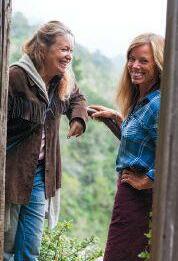
80 edible MONTEREY BAYSUMMER 2017
Intrepid hosts: top, foraging for mussels; bottom, the author and her friend, Julia Ingersoll.



















 BY KATHRYN MCKENZIE PHOTOGRAPHY BY KODIAK GREENWOOD
BY KATHRYN MCKENZIE PHOTOGRAPHY BY KODIAK GREENWOOD









 BY DEBORAH LUHRMAN PHOTOGRAPHY BY CRYSTAL BIRNS
BY DEBORAH LUHRMAN PHOTOGRAPHY BY CRYSTAL BIRNS




 BY SARAH WOOD
BY SARAH WOOD






















































 Courtesy Kyle Odell, bartender, Cultura–comida y bebida in Carmel
Courtesy Kyle Odell, bartender, Cultura–comida y bebida in Carmel










 Courtesy Yulanda Santos, pastry chef, Aubergine in Carmel
Courtesy Yulanda Santos, pastry chef, Aubergine in Carmel





 BY ELIZABETH LIMBACH PHOTOGRAPHY BY MICHELLE MAGDALENA
BY ELIZABETH LIMBACH PHOTOGRAPHY BY MICHELLE MAGDALENA










 BY JORDAN CHAMPAGNE PHOTOGRAPHY BY MARGAUX GIBBONS
BY JORDAN CHAMPAGNE PHOTOGRAPHY BY MARGAUX GIBBONS
















































































 BY LINDA SONRISA JONES PHOTOGRAPHY BY MICHELLE MAGDALENA
BY LINDA SONRISA JONES PHOTOGRAPHY BY MICHELLE MAGDALENA


